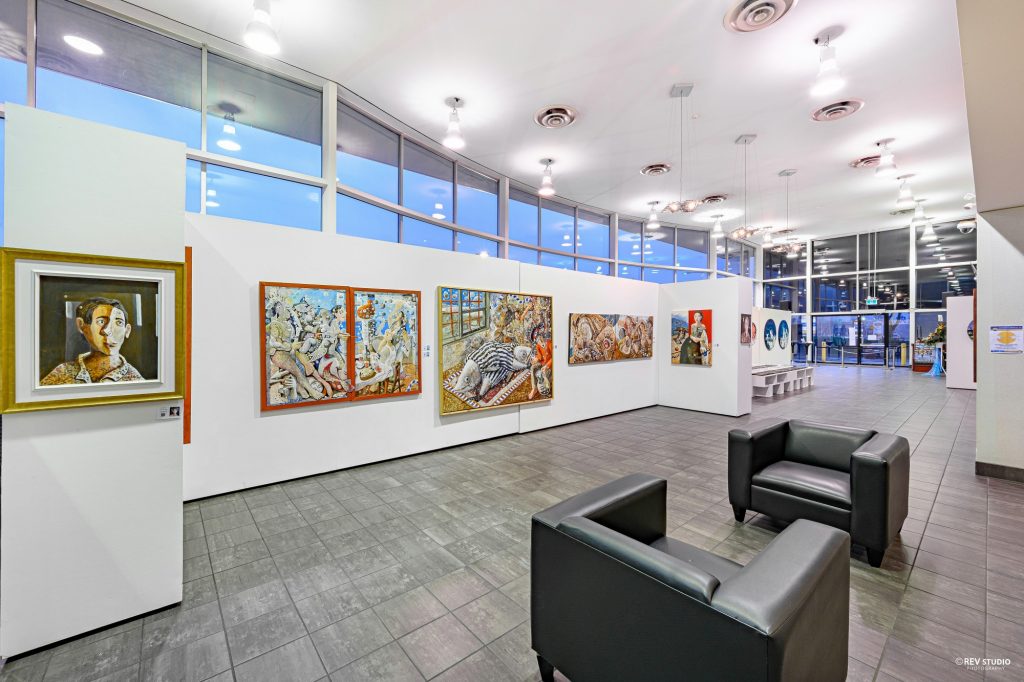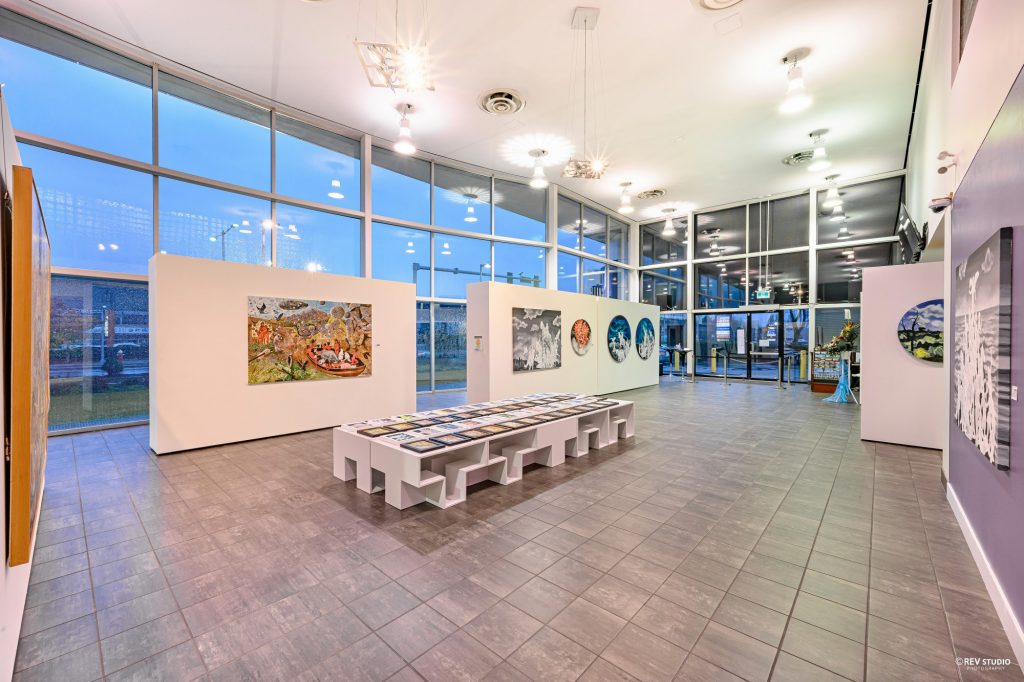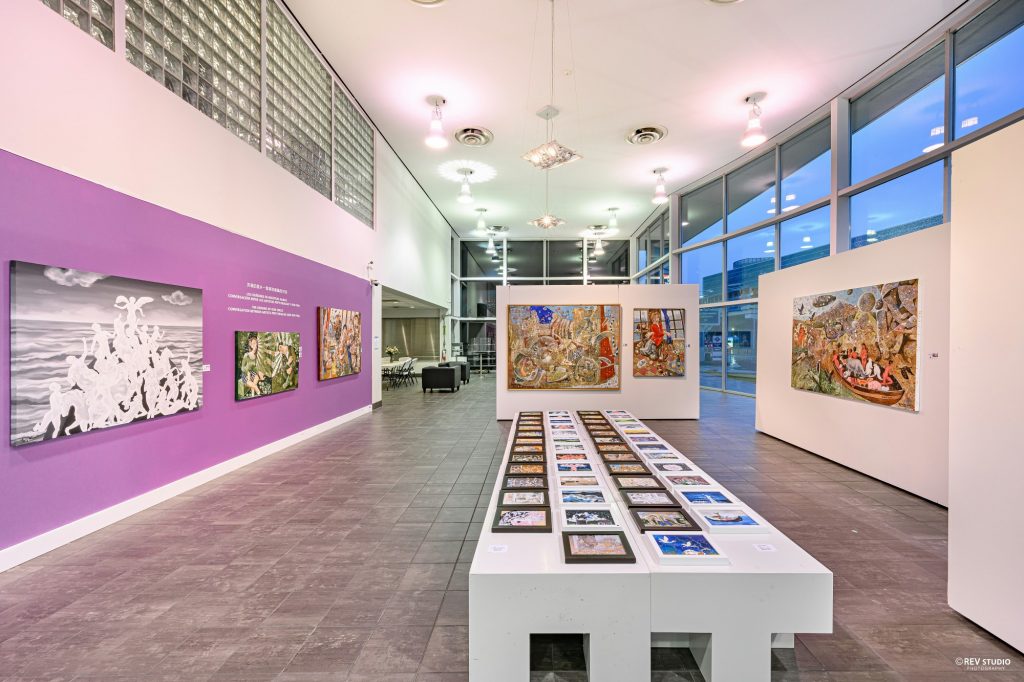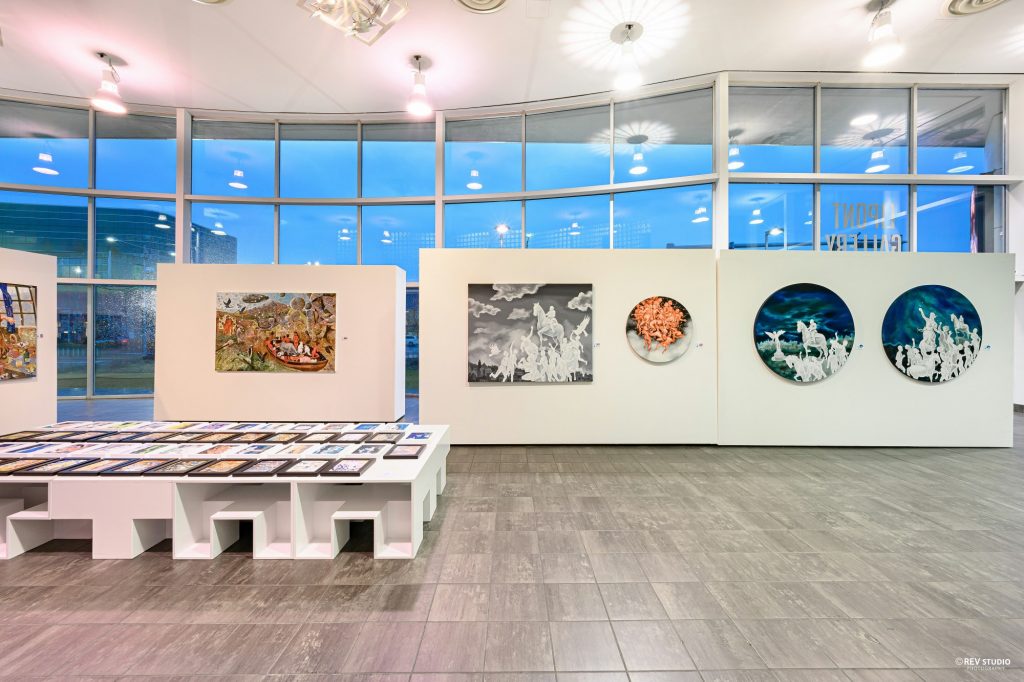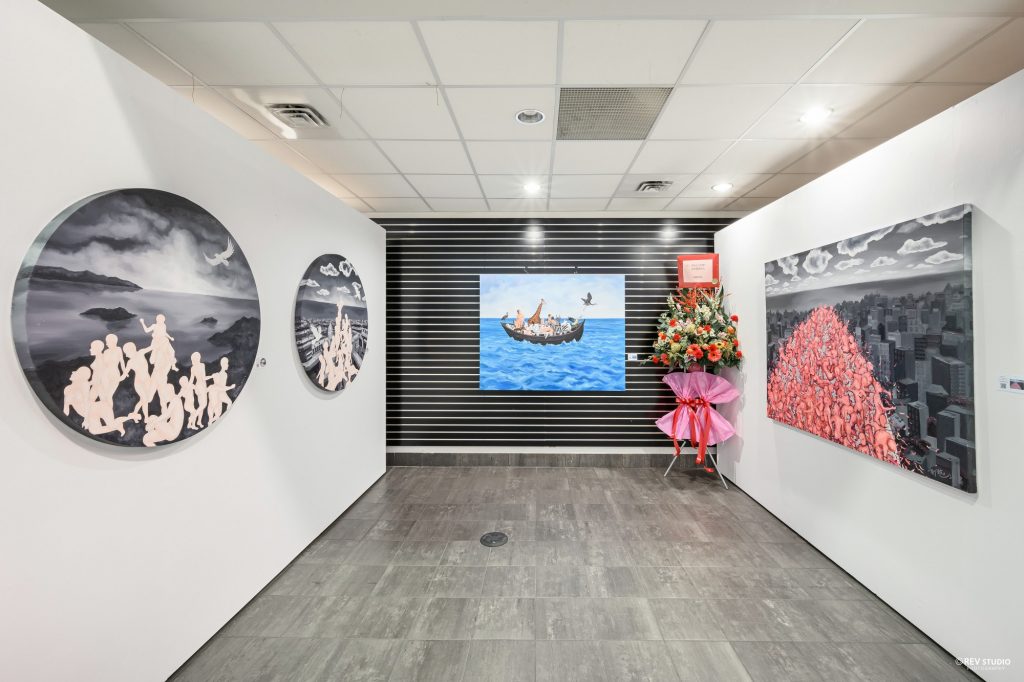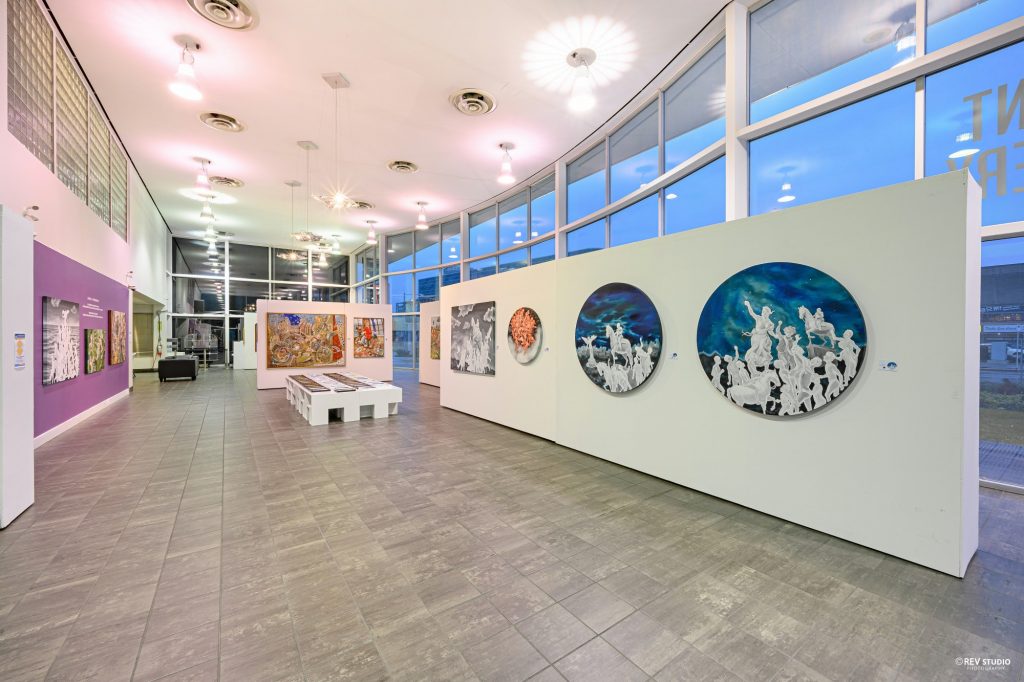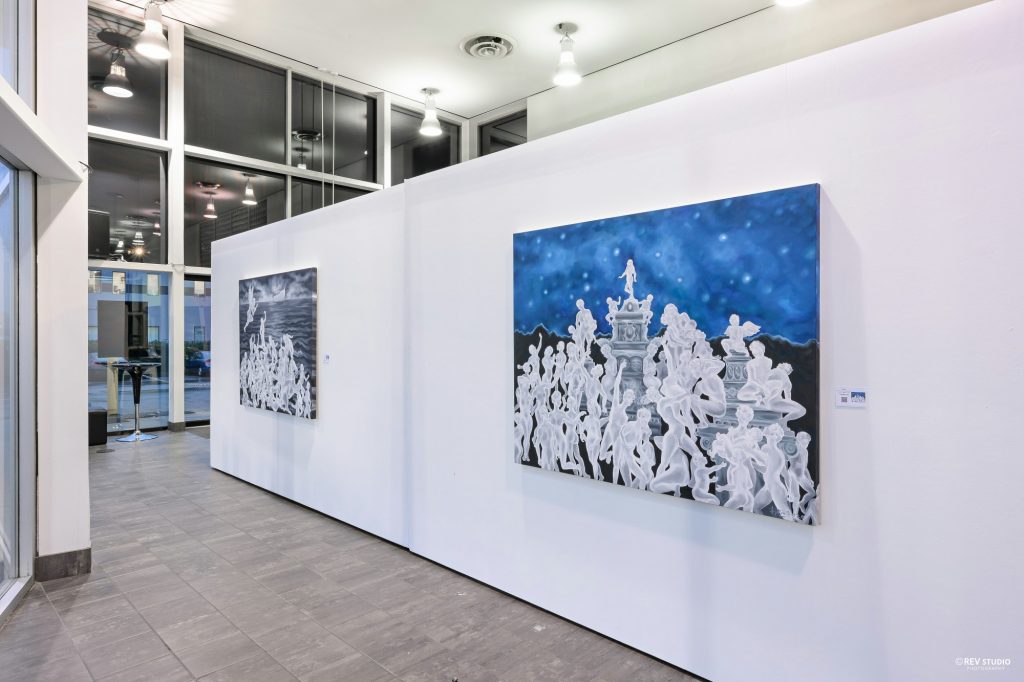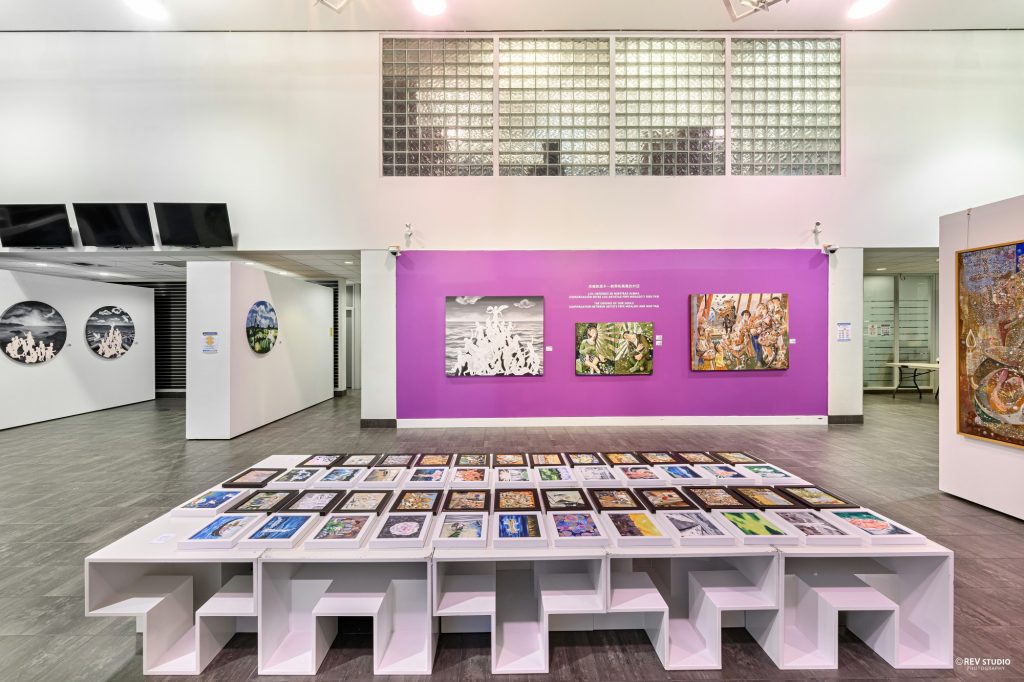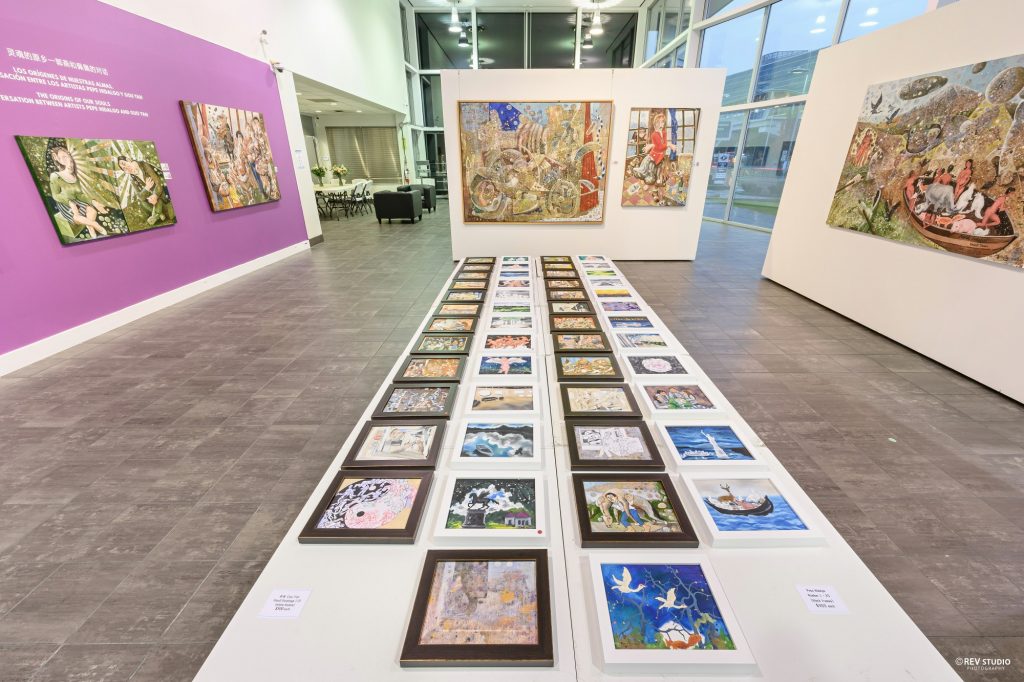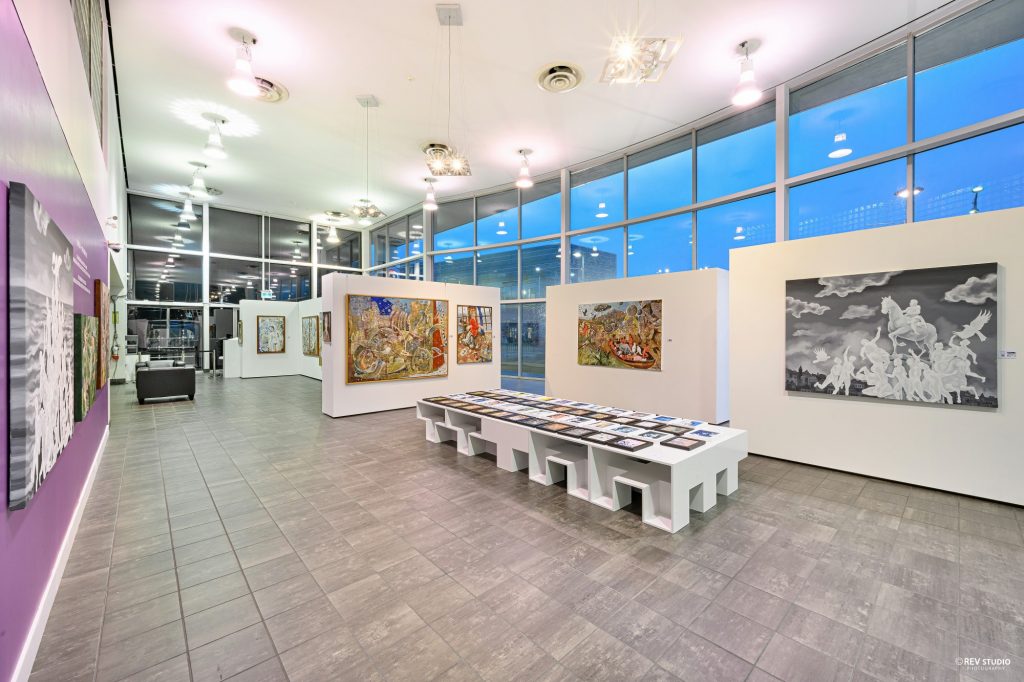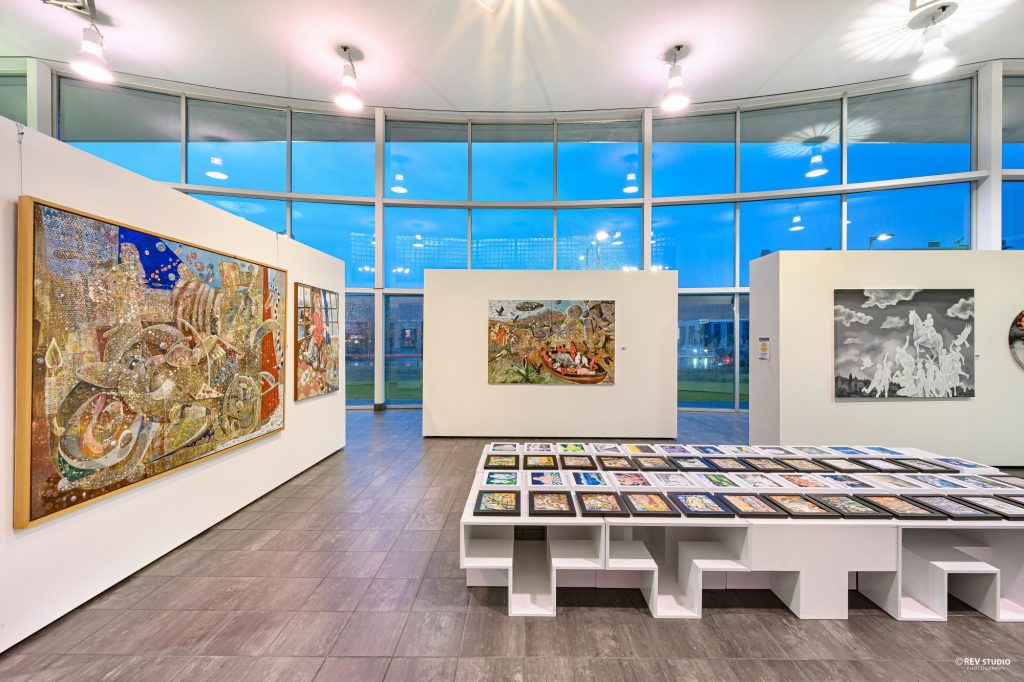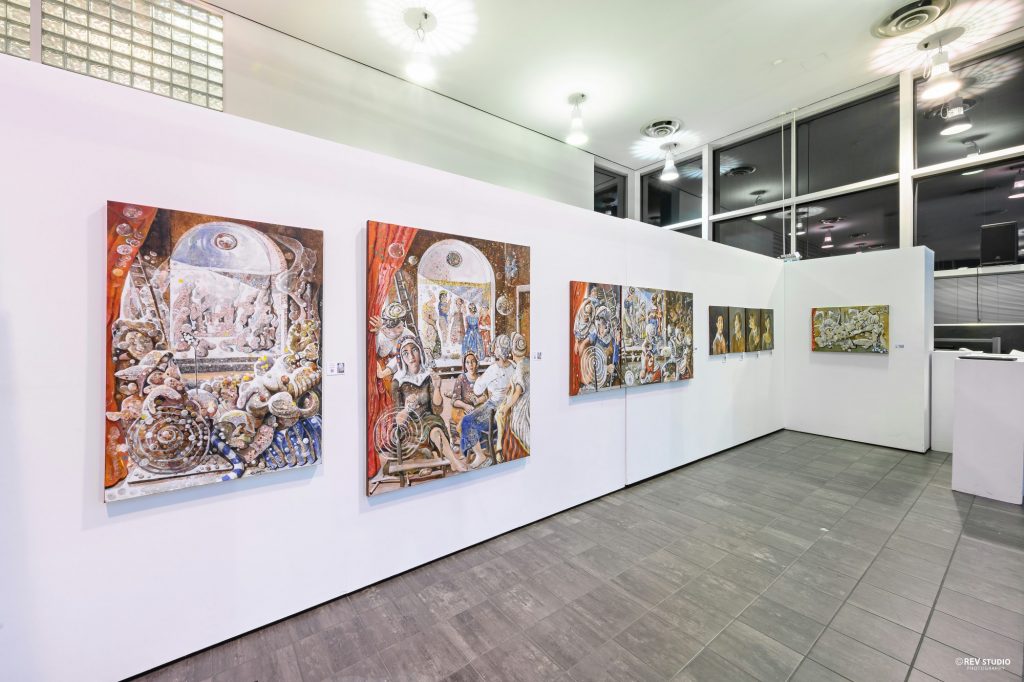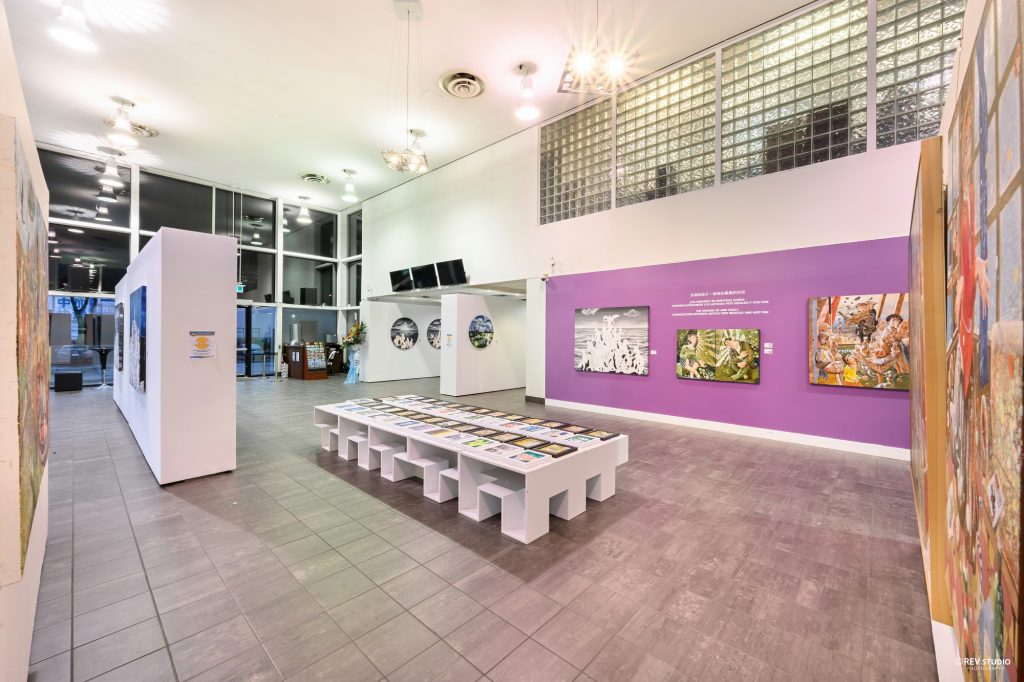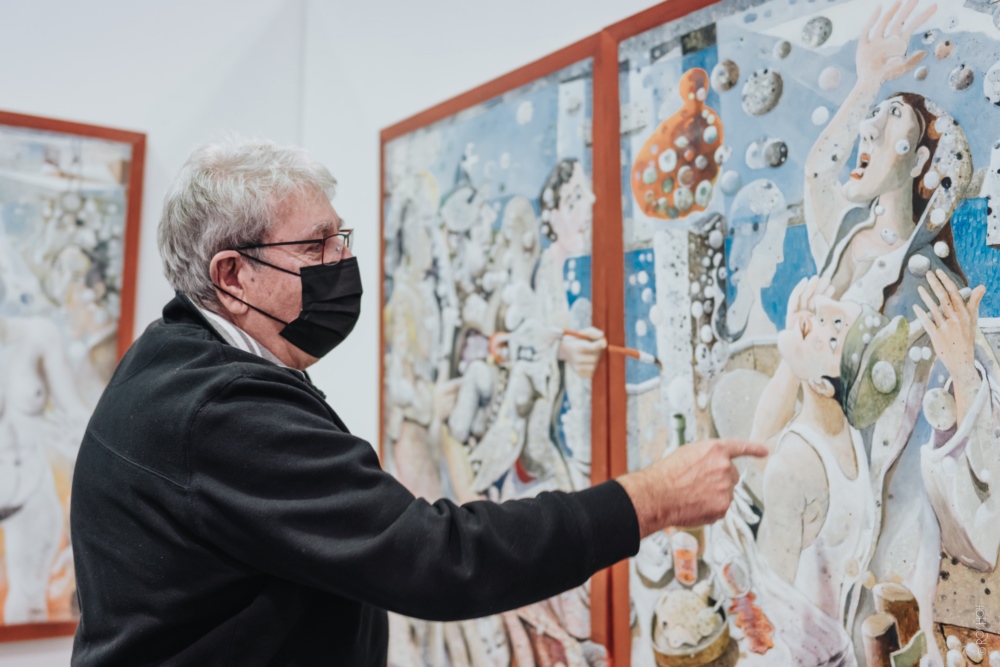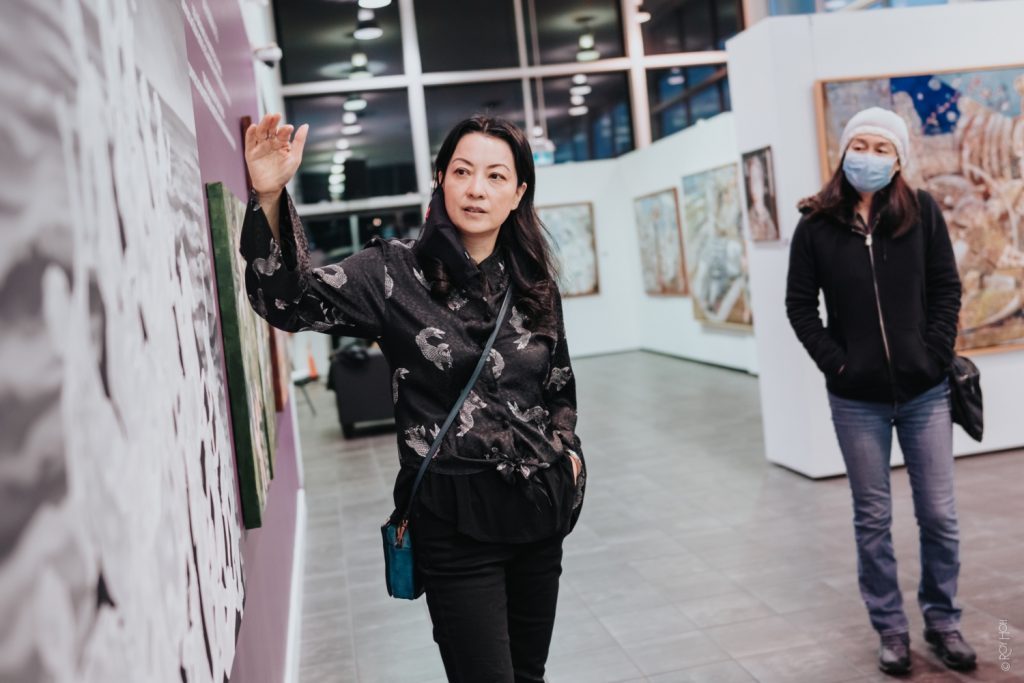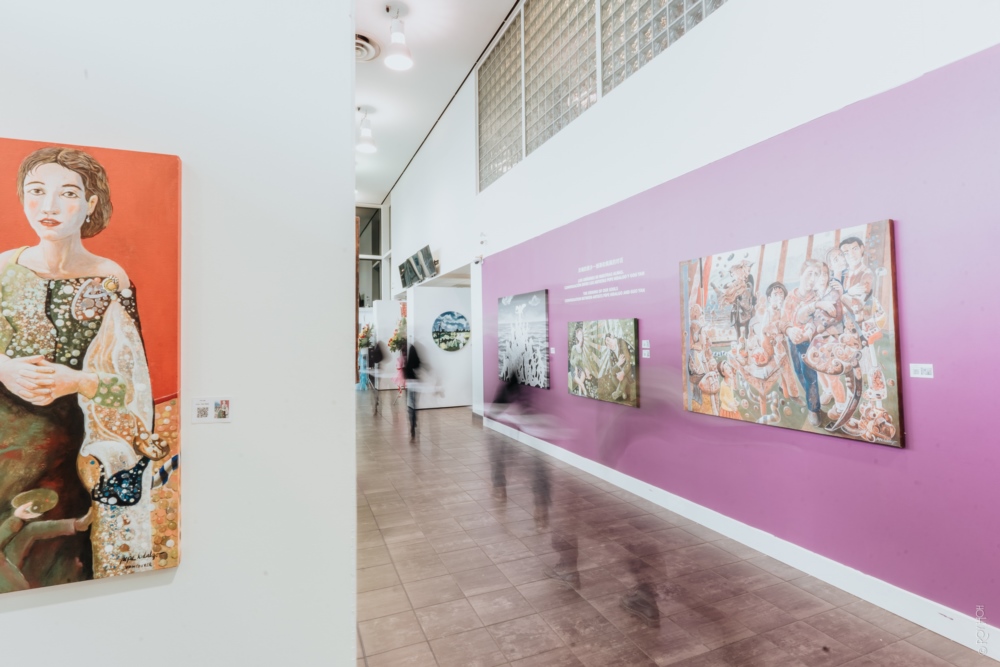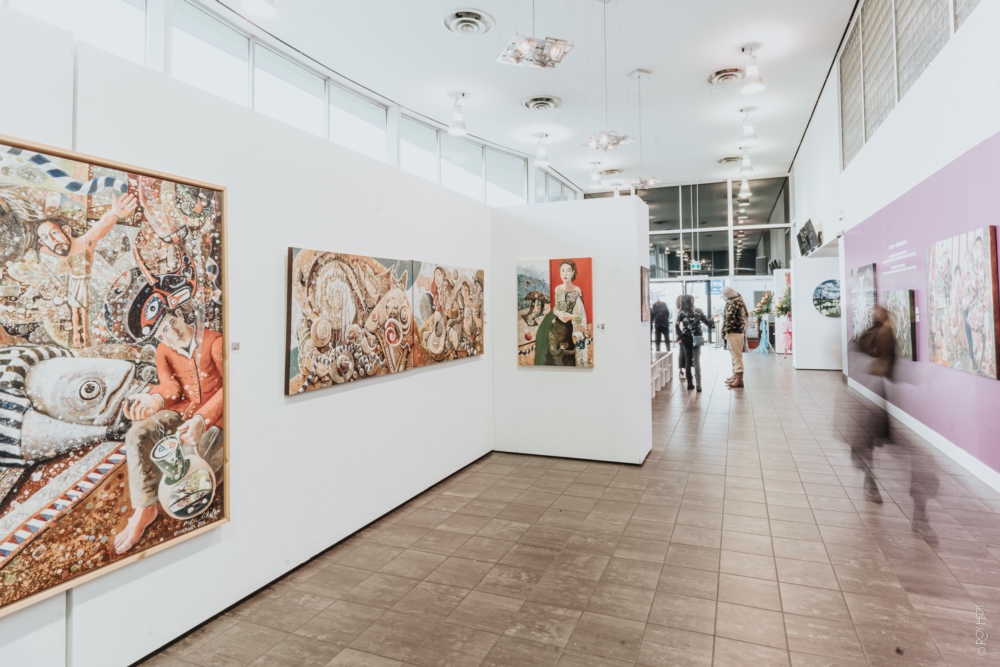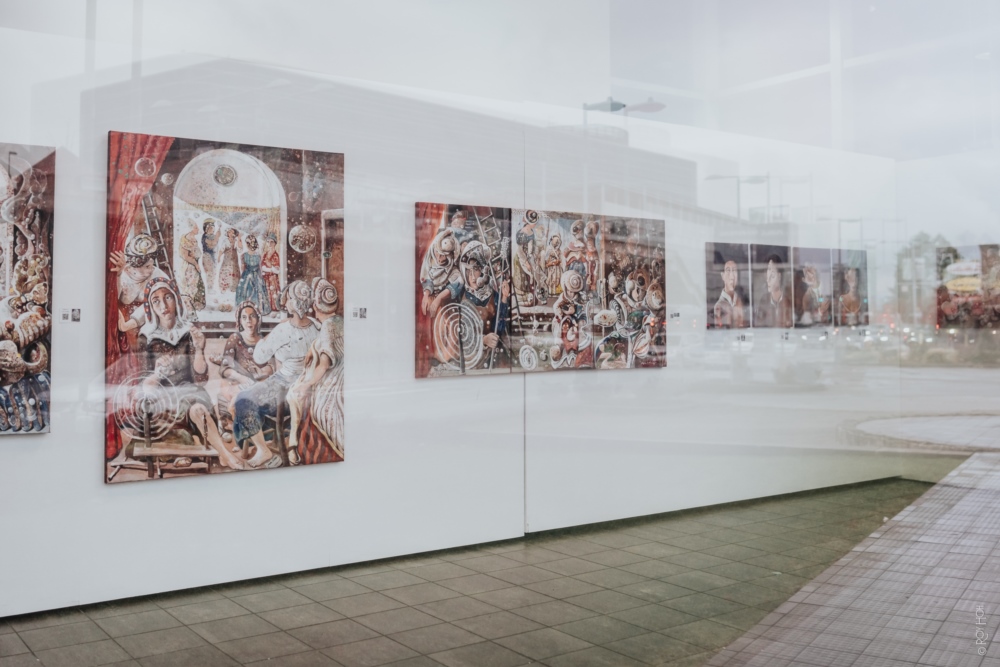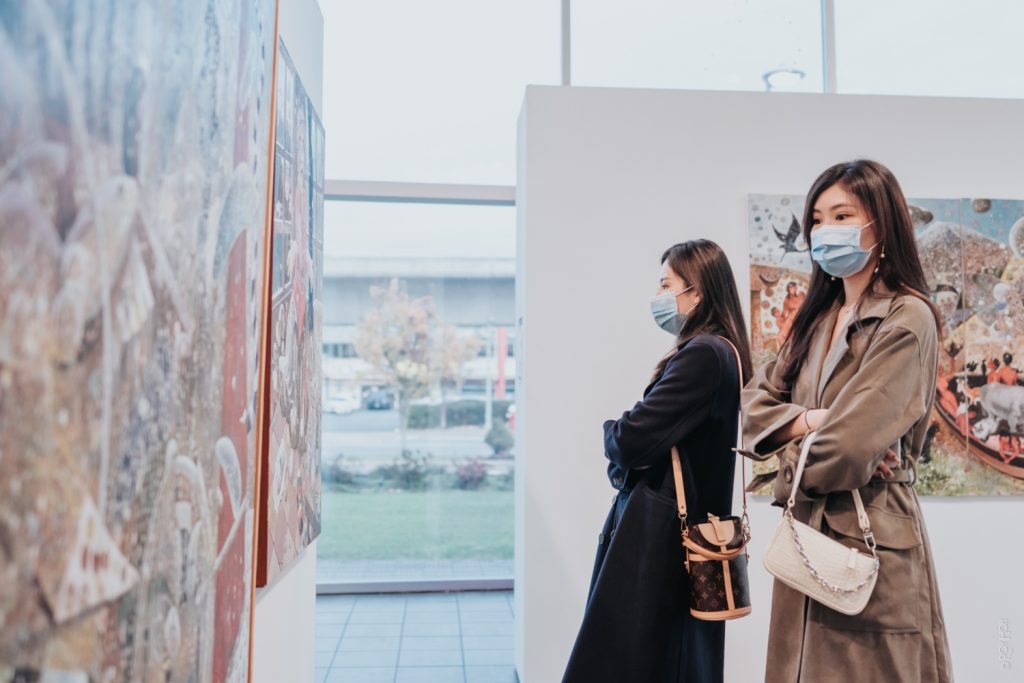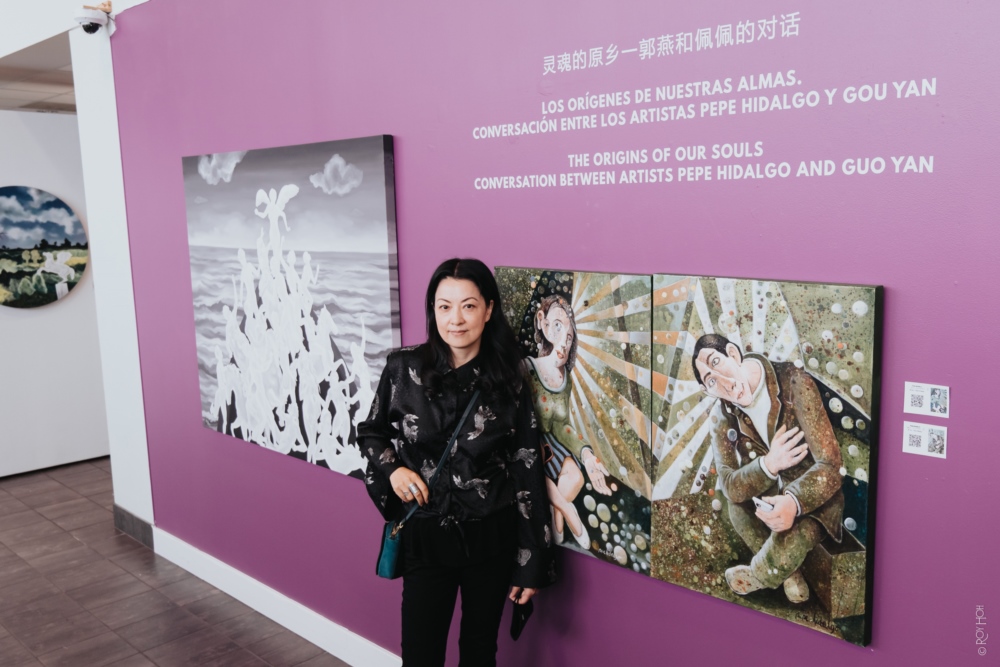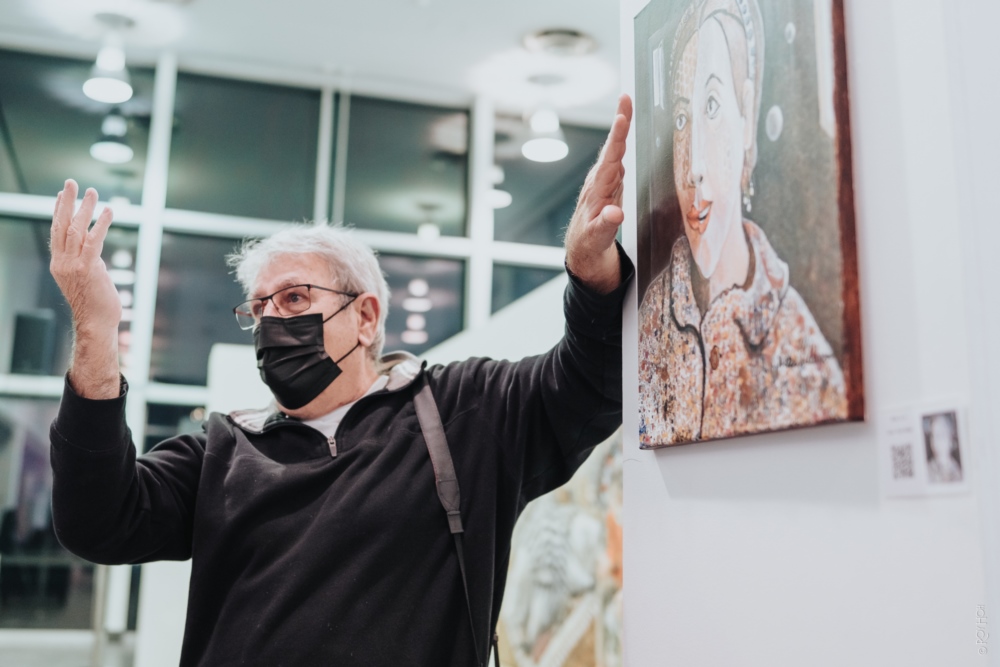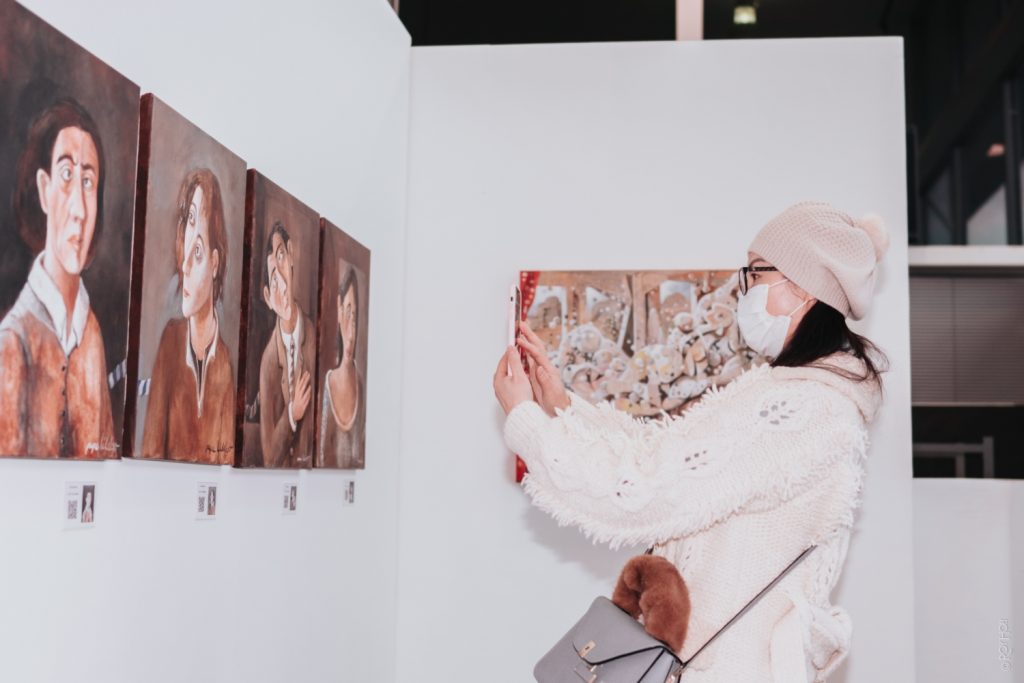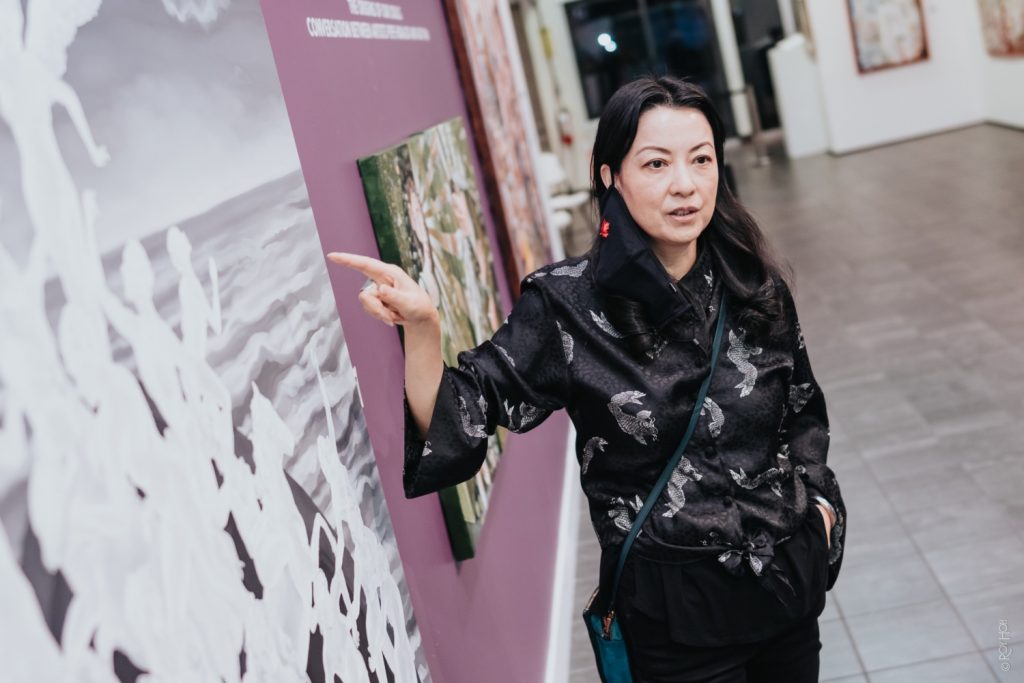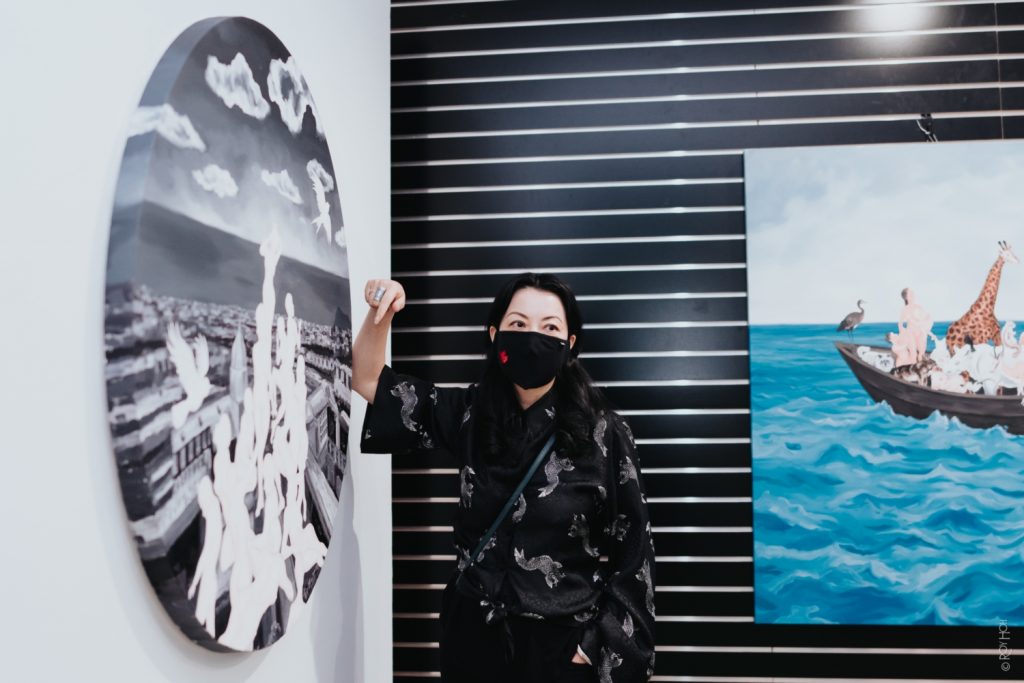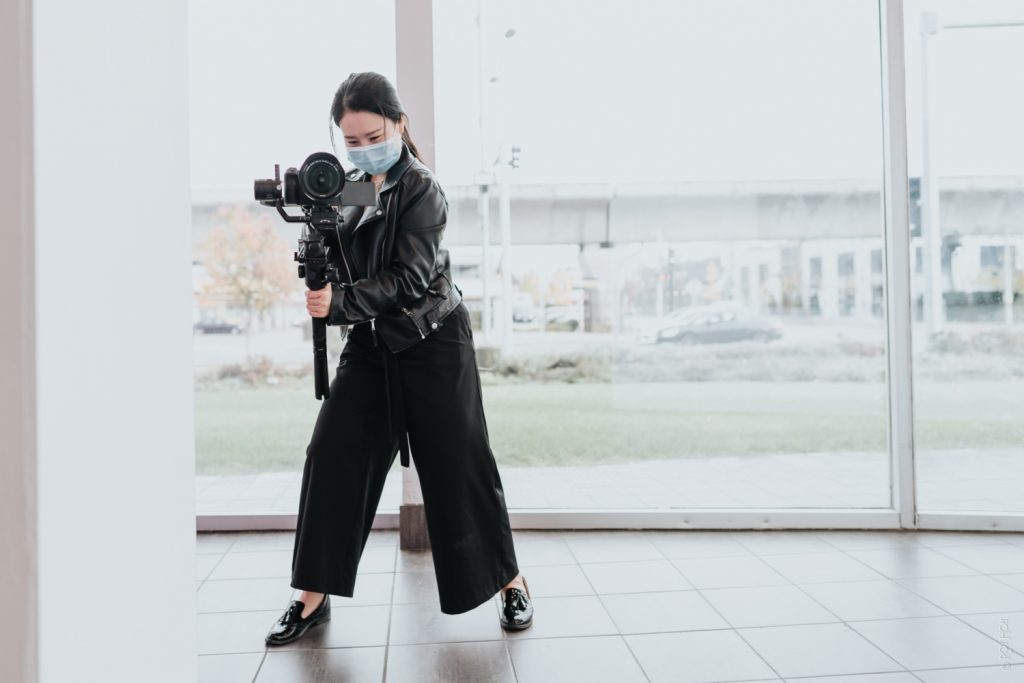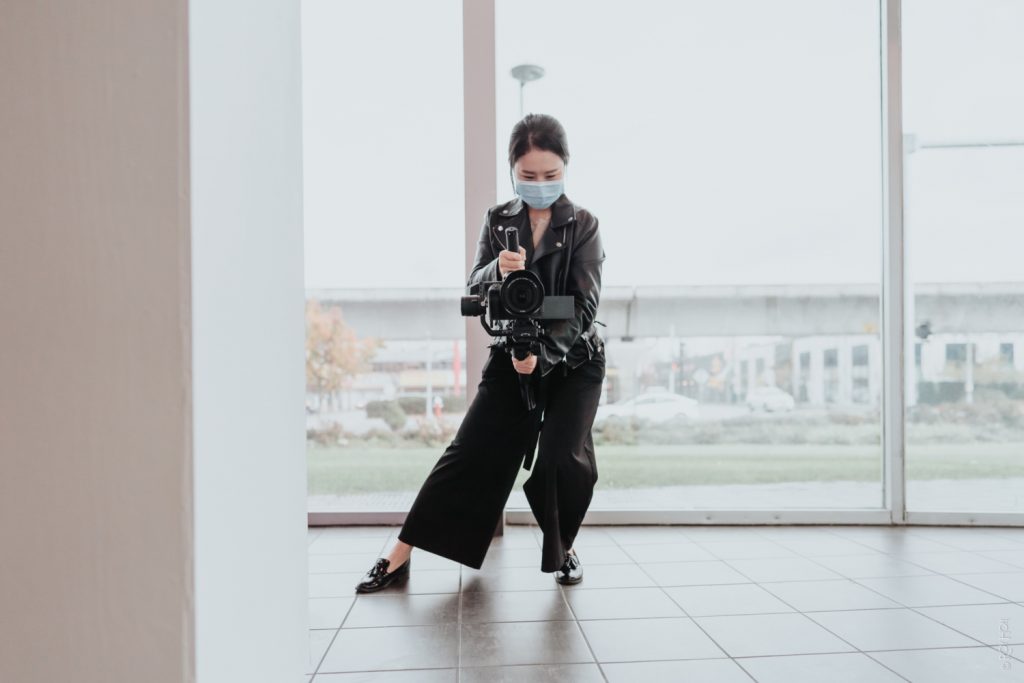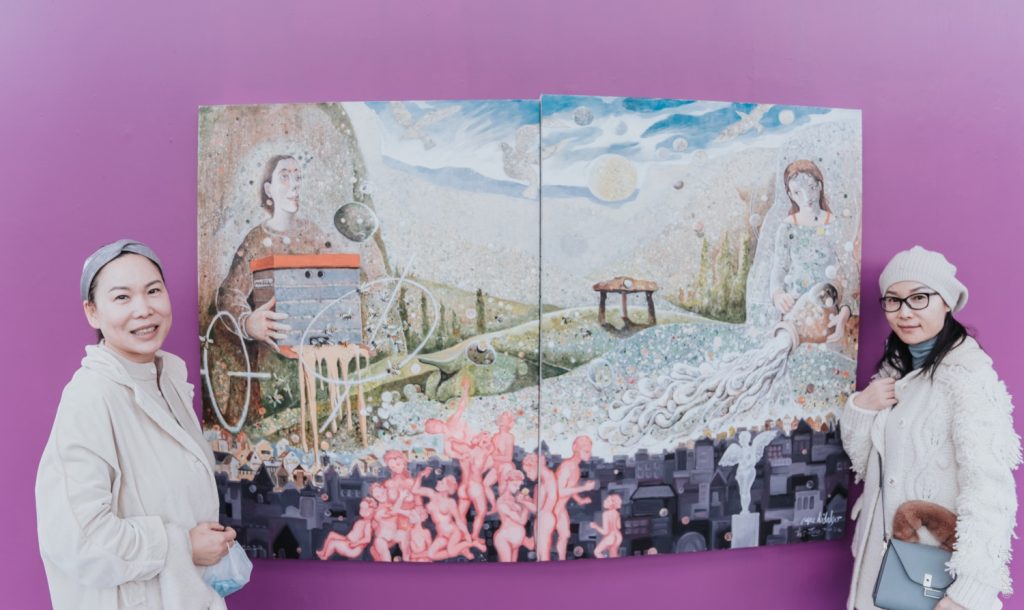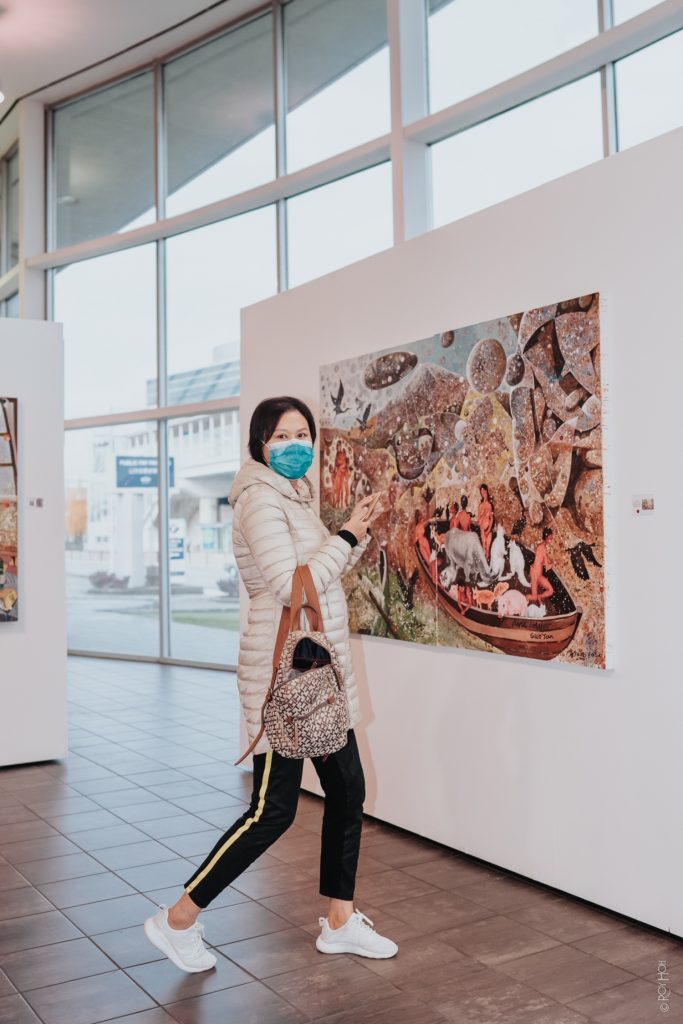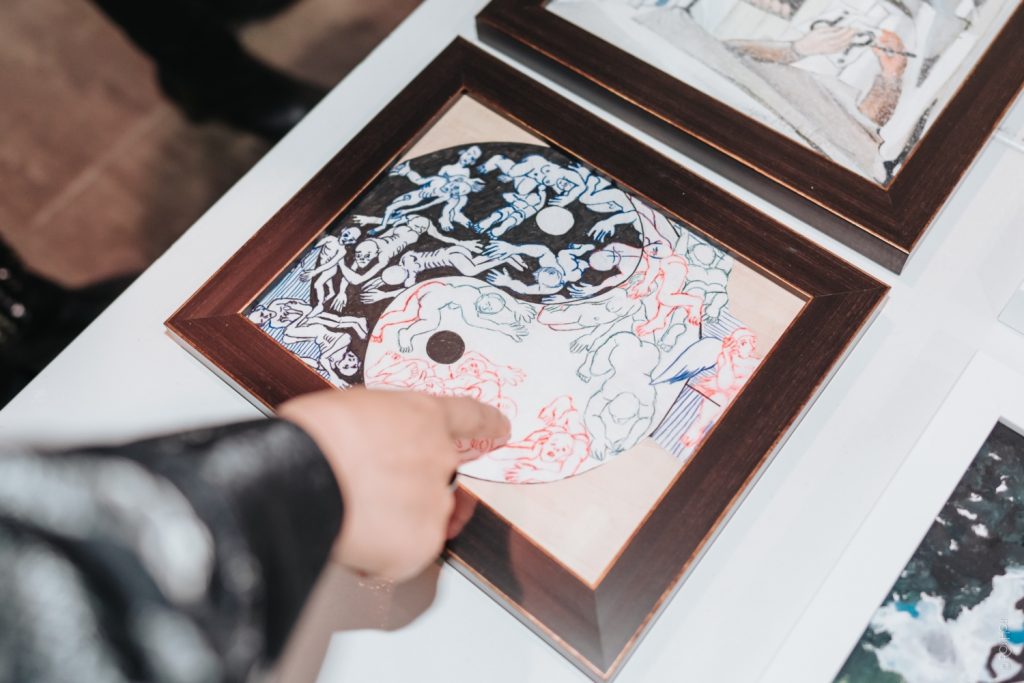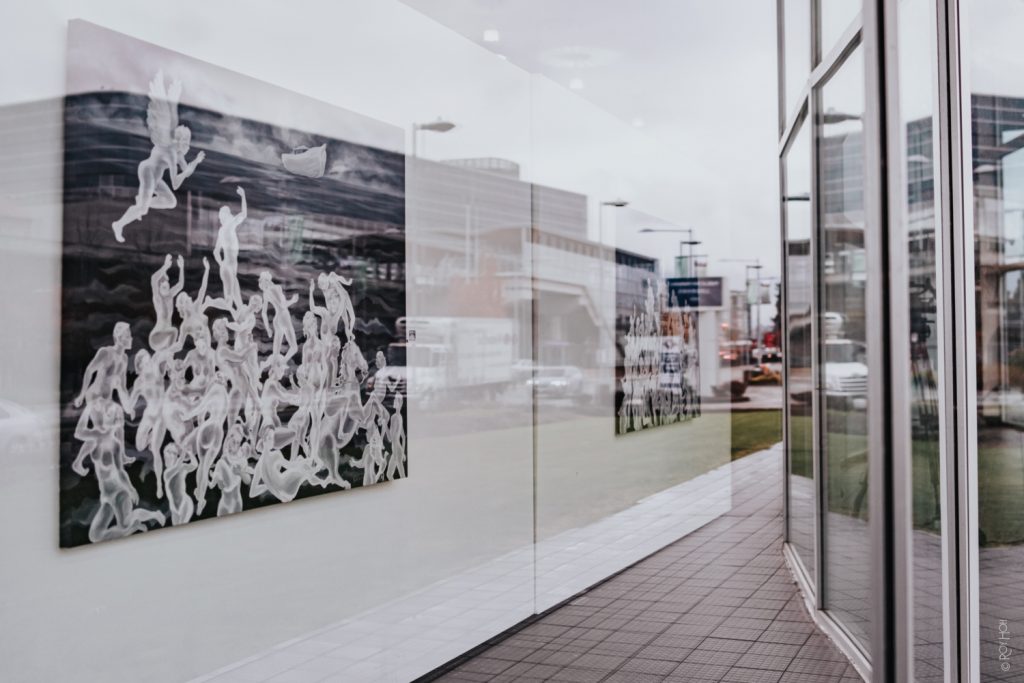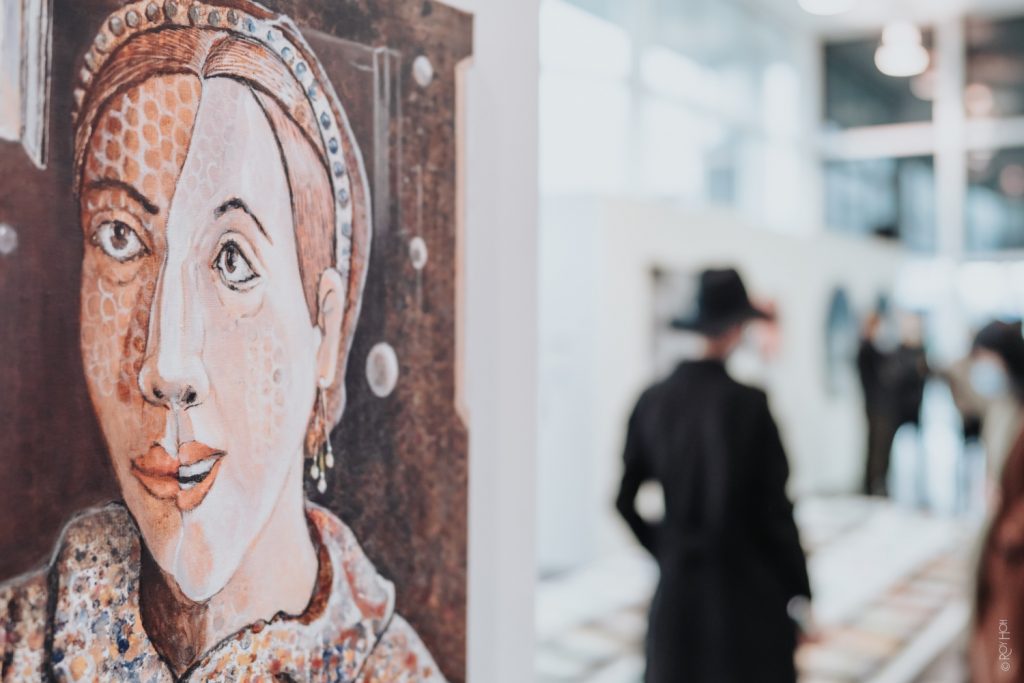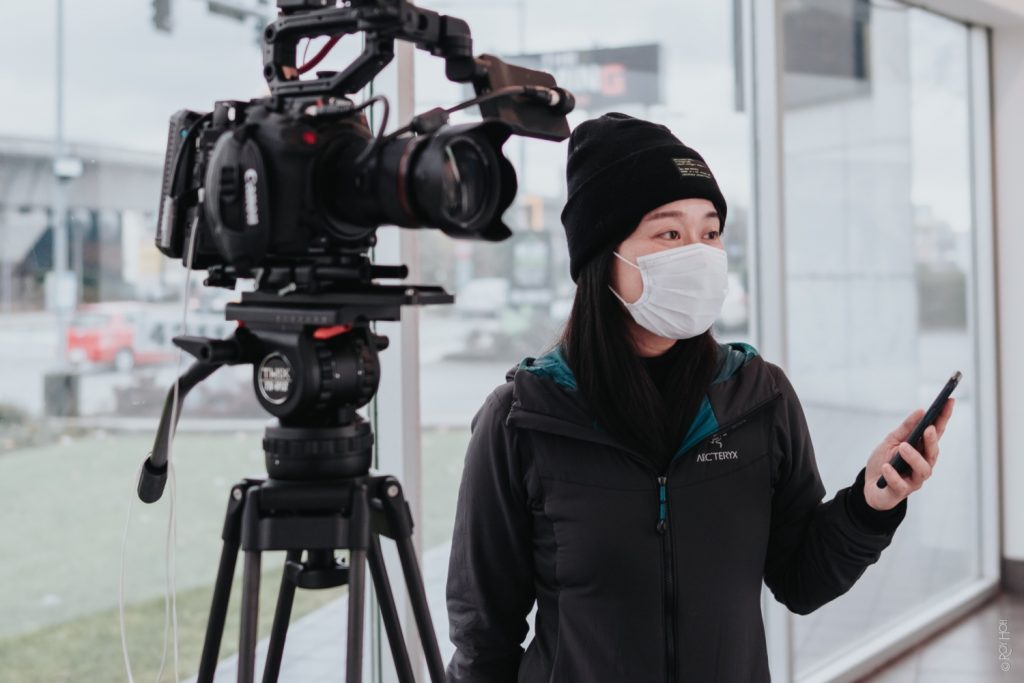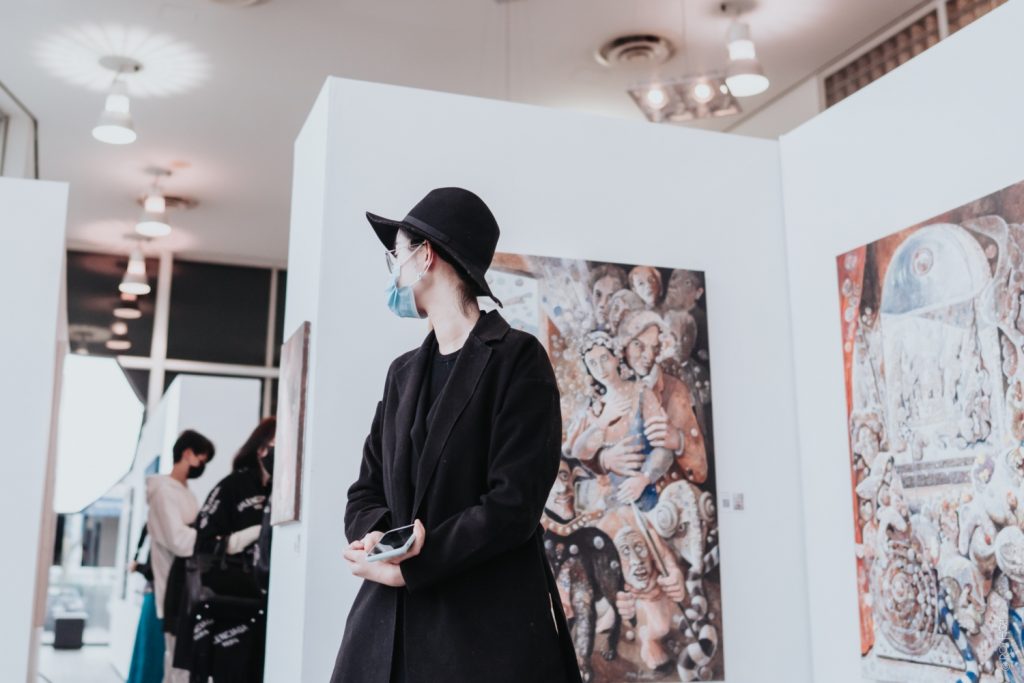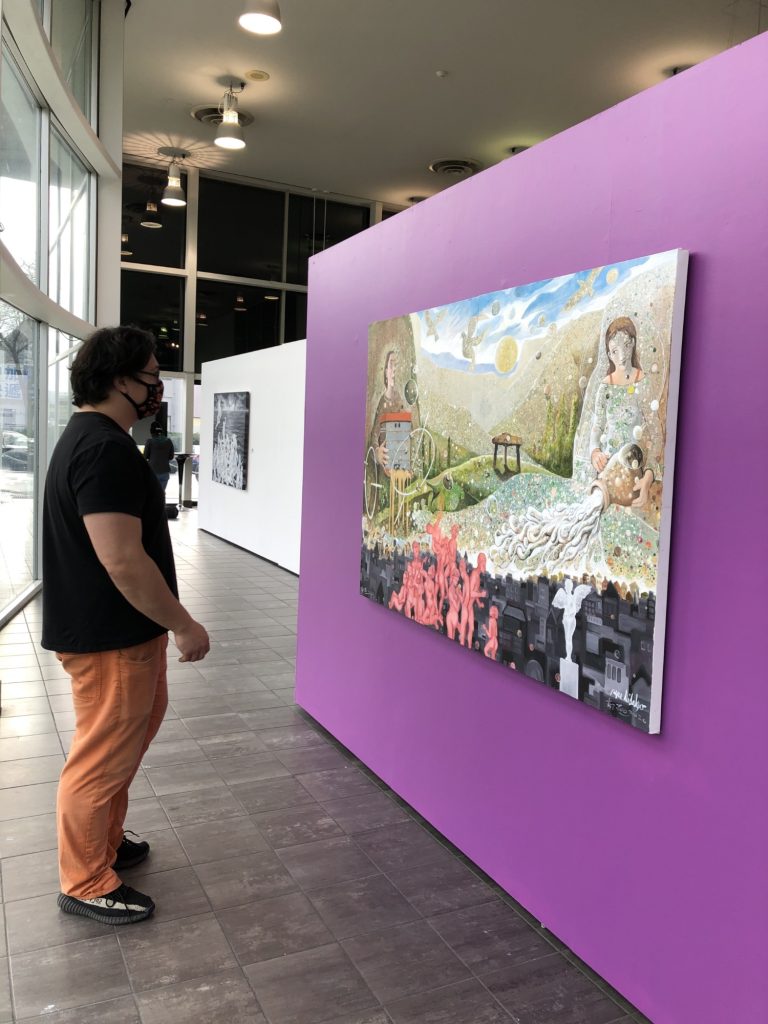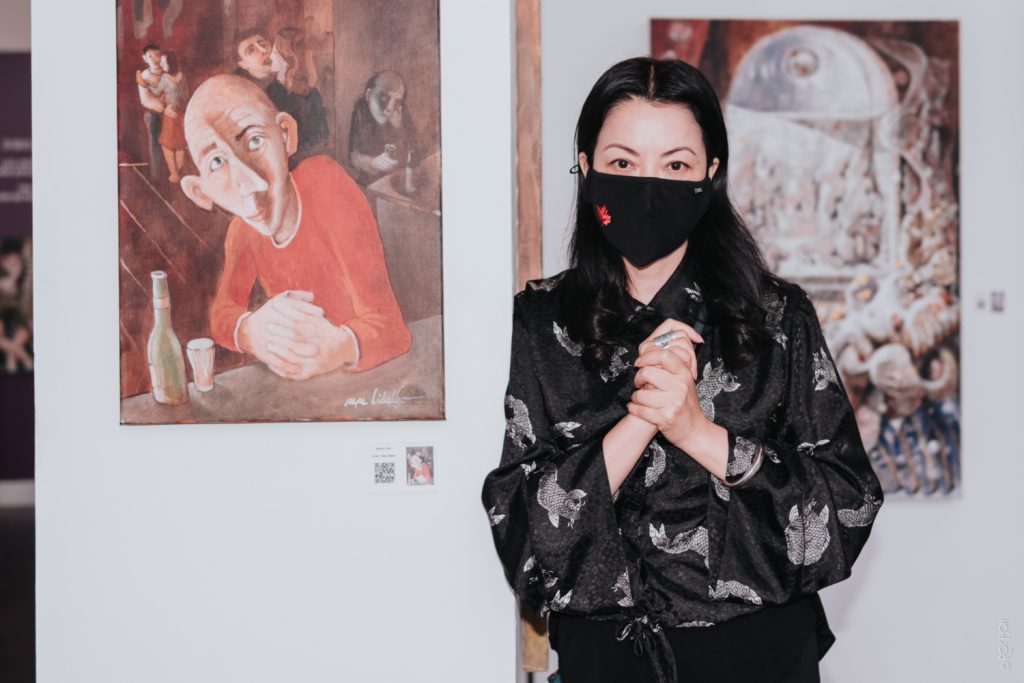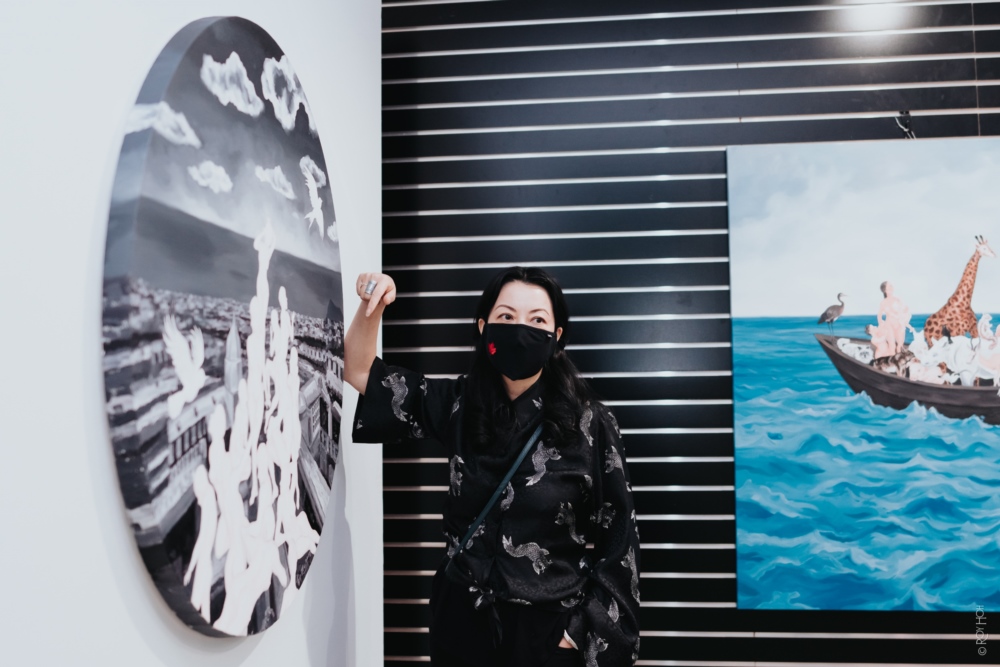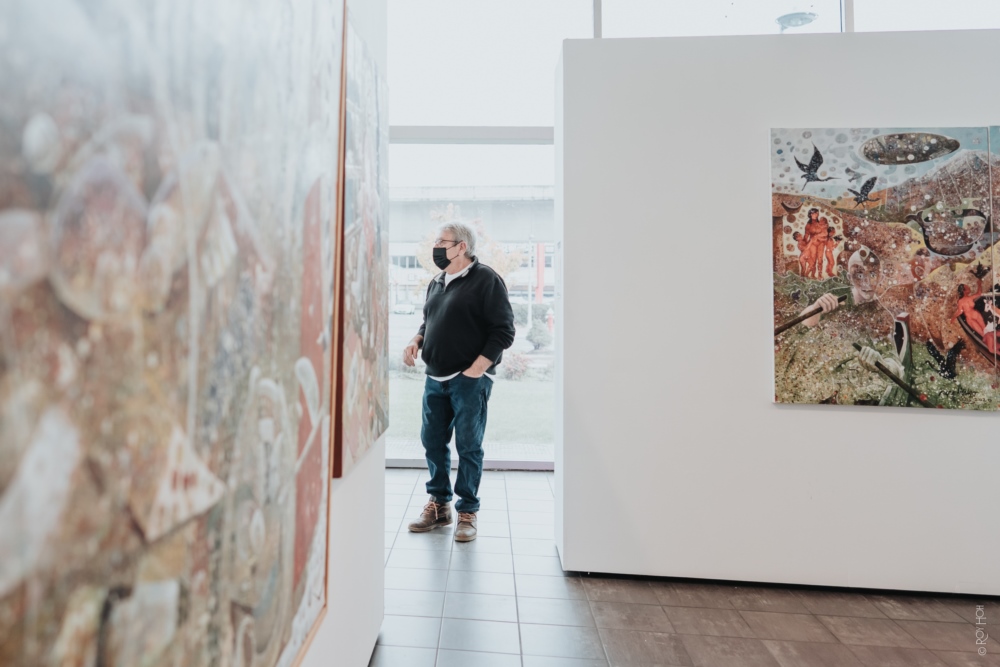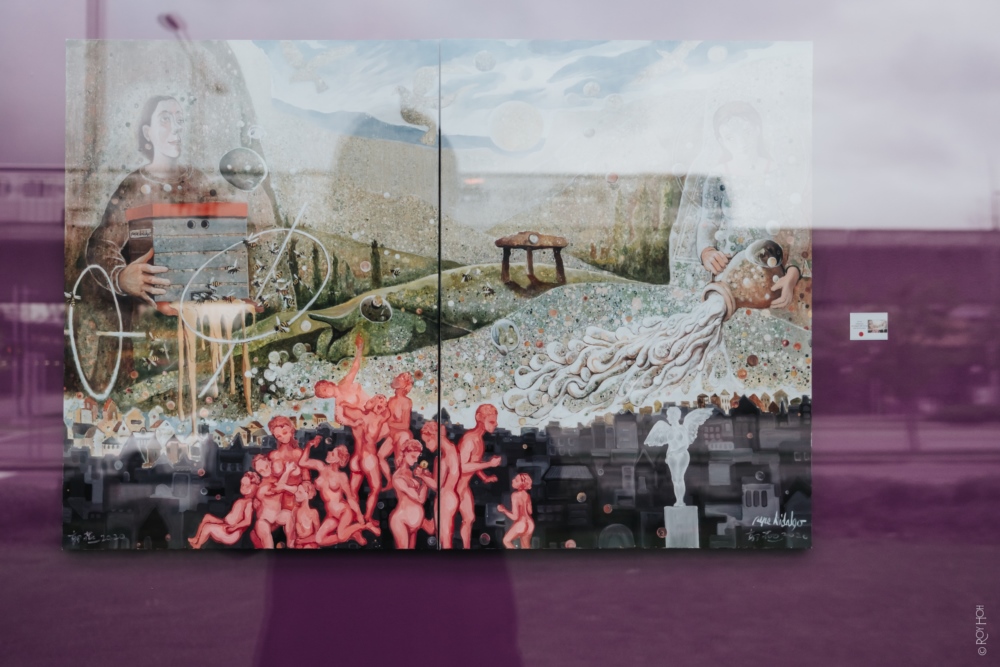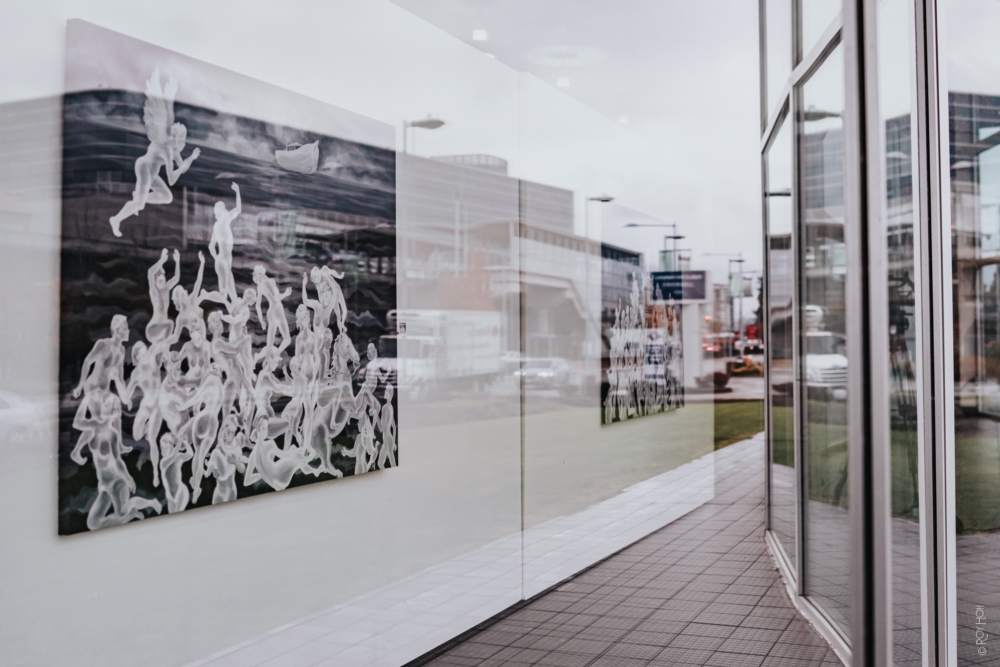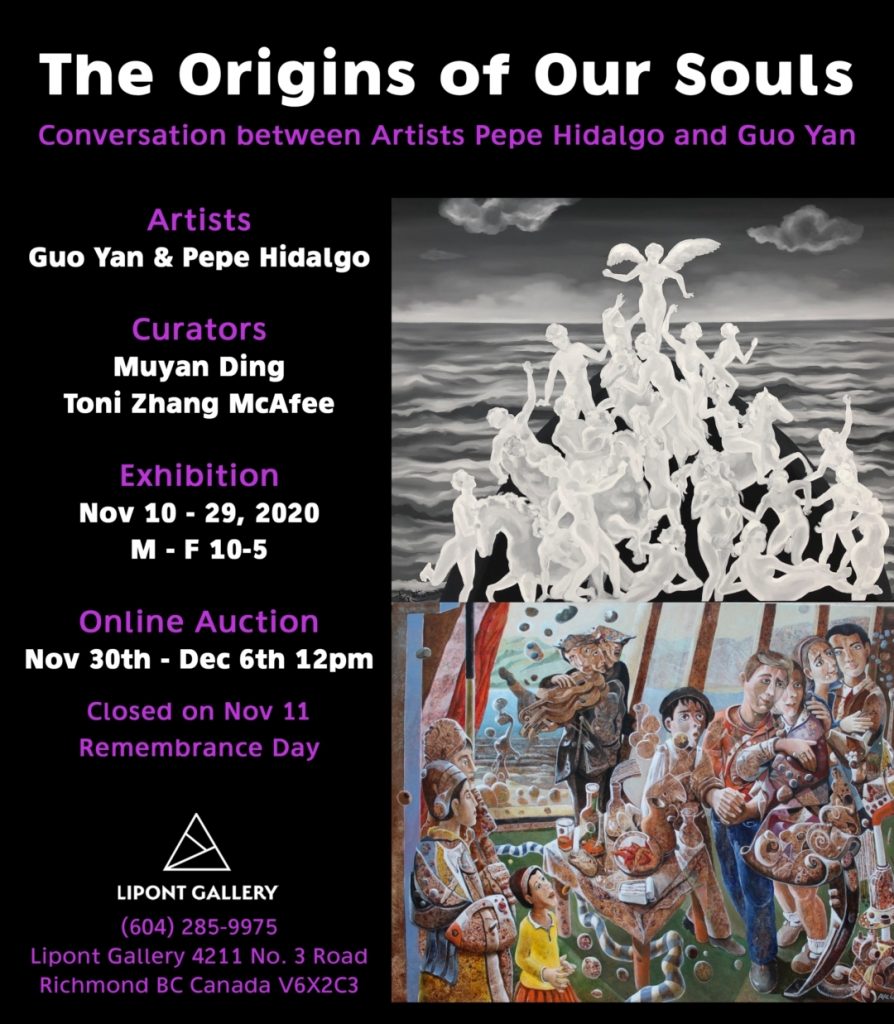
2021 The Origins of Our Souls Exhibition. Photo credit: Roy Hoh
The Origins of Our Souls – Art by Pepe Hidalgo and Guo Yan
Exhibition
November 10 – 27, 2020
Exhibition The Origins of Our Souls – Art by Pepe Hidalgo and Guo Yan showcases twenty five medium to large scale acrylic paintings by artist Pepe Hidalgo, a renowned Spanish artist living in Delta, BC; thirteen large-scale oil paintings by Chinese-Canadian artist Guo Yan; and twenty five pairs of 8 x 10 inches paintings, of which odd numbered paintings are by artist Pepe Hidalgo, the corresponding even numbered paintings are by artist Guo Yan. Each pair of paintings are the result of the duo’s communication over the language barrier with the help of Hidalgo’s wife Noreen Marte and Guo Yan’s English-speaking friends.
Hidalgo speaks Spanish. Guo Yan speaks Mandarin. They met at an exhibition titled Bridges of Friendship in 2019 at Lipont Gallery, which was organized by the Consulate of Mexico in Vancouver on an annual basis to bring together Mexican artists and local artists of different cultural background to showcase their recent artworks and enrich the cultural life of the community. The two artists’ conversation started at Hidalgo’s painting The Spinners, which is a contemporary interpretation of Diego Velázquez’ masterpiece Las Hilanderas (The Spinners).
Shortly after, Hidalgo and Guo kicked off on a year-long collaboration of the twenty-five pairs of paintings despite the language barrier. They considered it innovative soul-to-soul communication. It was revolutionary for both artists’ careers and the results are stunning. The themes of the paintings touch on folklores, cultural symbols, local art scenes, abstract subjects, cityscapes around the globe, spaces that inspired them and so on.
“Although our styles cannot be more different, coincidences keep happening in our paintings, such as the subject matter. We have a common love for classic works that have influenced us throughout our careers. We must admit that each of us is a prisoner of culture. The art education we have received affects us like a brand, which is reflected in our works without fail.” – Guo Yan 2020
During the year-long collaboration, they each finished a body of work prolifically in their own unique styles as well, which are on view together with the twenty-five pairs of paintings at Lipont Gallery from November 10 – 27, 2020 and virtually at https://my.matterport.com/show/?m=Fwc2qQ9bxhM
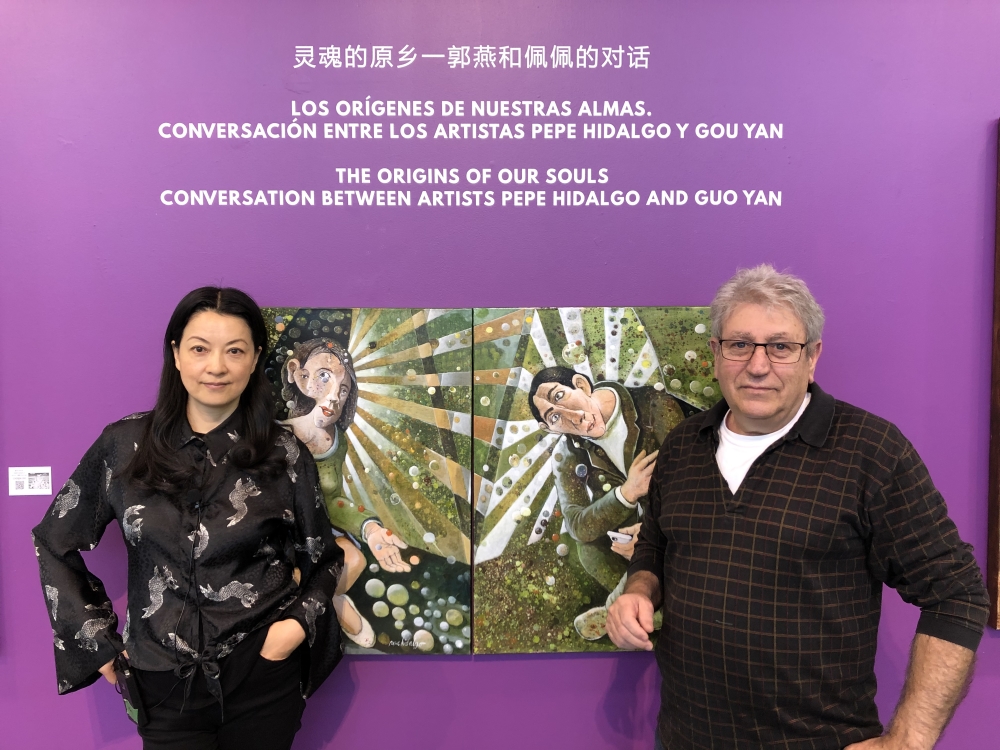
[dt_sc_image_caption title=”Pepe Hidalgo” image=”16968″][/dt_sc_image_caption]
Pepe Hidalgo
Pepe Hidalgo was born in Spain and now resides in Vancouver. He predominantly paints with acrylic and sketches. Hidalgo studied fine arts in Utrecht, Netherlands. Hidalgo has a distinct element present in his paintings. There is a string or cord that can be seen in most of his work. It acts as the umbilical cord that unites him to the universe and allows him to time travel back and forth as it supports his weight and pulls him back into reality. It also takes on the role of identity maker and can almost be considered to replace his signature.
Pepe Hidalgo Artist Statement
Standing in front of each painting one encounters a moment in time created within the world depicted on the canvas. Each of the paintings is representational, depicts, and thus constructs, a world with a unique space-time that is separate from the one which the viewer primarily inhabits. What each of the depicted moments share is that they present moments of leisure or rest, moments when time slows or even stops, sometimes briefly, at others permanently. Moments in one place and then into another place. These paintings allow one to travel, to cross spaces, borders, time, dimensions, and then return.
The pieces often have an intimate personal ring to them, but they are also closely connected to mythological and mysterious distant natures, personal elements that show both the process side and the object side of the art-making experience. The scenarios in each work have their own story, their own relation to theory and history within art, within the art world and outside of it as well. This conjuring of a range of ‘pasts’ become the unifying element in the series. Objects with historical associations make up metaphors for the great differences and dissimilar points of departure that human beings are allotted. Hidalgo’s art invokes the ever-ineffable nature of time and the equally mysterious way that the past, in art and in the rest of life, can push its way forward into the present moment.
[dt_sc_image_caption image=”16971″ title=”Guo Yan”][/dt_sc_image_caption]
Guo Yan (郭燕)
Guo is an artist who is extremely sensitive but aims high. Unlike other female peers obsessed about their women’s identity and emotional struggles, she focuses more on people’s life and experience as well as social evolution and clash. In her tiny body lives a strong and compassionate soul. Inspired by but never confined to individual experiences and reflections on life, she has the insights into the real life and mental crisis of people across a generation. That is the quality and power that has made her an excellent modern artist.
– Liang Kegang, artist, curator and critic 2016
Although Guo Yan is an optimistic and open-minded person in the eyes of her friends, I think she is a pessimist in her heart and a very thoughtful artist. She is a vegetarian and she loves nature. In the real world, she always has a strong sense of crisis. She is also an environmentalist. She prefers a simple, pure, low-carbon, minimalist life. She keeps her material in a very low state. She is a very professional artist and spends a lot of time on oil paintings every day. Many of her works are in the collections of arts and cultural institutions in China and abroad.
Communicating through Art
Shengtian Zheng
Art has no borders. Communicating through art doesn’t need verbal language. Now, as we are living in a word that is increasingly divided by virus, the political system, or ideology, the importance of art is more obvious, and the public’s need for art is greater than ever.
I remember the first time I saw the original of Picasso’s Guernica, in 1981, at the MoMA in New York. Standing in front of it, I suddenly felt a chill go through my body. You don’t need to know that part of Spanish history to understand this painting — it speaks of the massive destruction and the deep trauma of war— a feeling of inconsolable grief shared collectively by mankind. This 1937 painting Guernica returned to its motherland almost half a century later, in accordance with Picasso’s wishes. Every time I visit Madrid, I make sure to go to the Reina Sofia Museum and pay my respects. Because it is the only painting in the world that could really make me hold my breath and cry.
Scrolling back through my memories, another story of art and communication comes to the fore. It also occurred during the Spanish Civil War. A Chinese student C. Chuang came to Barcelona from France where he was studying literature. He met a Catalan girl Francesca and fell hopelessly in love. At the outbreak of World War Two, the two diverted themselves to China, to set up residence in the outskirts of Kunming where they raised five beautiful children. After the end of the Cultural Revolution, the members of the Chuang family returned one after another to reside in that romantic city.
In 1989, while travelling in Spain, I became acquainted with this family. They all possessed a deep love of art and music and we developed such a warm and intimate connection that I soon became like one of the family. The children asked me to call their mother “godmother”. Francesca even treated me to a rich seafood stew as a way of welcoming me to their family. The next day, I asked her to sit for an oil painting. Everyone praised the portrait captured the spiritual likeness of their elderly mother. Speaking in Chinese, Francesca said to me, “While watching you paint, I realized that you painted me with such spontaneity that you must have been thinking of your own mother at the same time.”
I was very happy to have the chance to see Spanish artist Pepe Hidalgo collaborating with Chinese artist Guo Yan in Vancouver. The process of the dialogue between the two artists was actually a moving artwork in itself. The first painting which they collaborated on was Back to Mount Ararat. I have always wanted to visit both Turkey and Armenia. The famous Armenian painter Ivan Aivazovsky not only created the famous work The Ninth Wave, but also The Descent of Noah from Mount Ararat, held in the collection of the National Gallery of Armenia. Now the snowy peaks of Ararat can only stand mutely by as the flames of war erupt below the mountain. It seems that the tragedy of Guernica is destined to be continually restaged in different corners of the globe. If humanity is one day forced to escape, taking refuge on an ark, I hope the population of that ark are all art enthusiasts, in this case there will be no issues of communication.
Zheng Shengtian, October 16, 2020
艺术的沟通
郑胜天
艺术从来没有国界。艺术的对话也不用语言。在我们当今被病毒、体制和意识形态越来越隔离的世界中,艺术的作用可能比任何时候都更彰显,也更为人们所需要。
记得1981年我在纽约现代美术馆(MOMA)第一次见到毕加索的《格尼卡》原作,霎那间身上感到一阵寒颤。你不必了解西班牙的历史才能看懂这幅画。它诉说的是战争带来的巨大破坏和深重创伤,是人类共有的哀痛欲绝的经历。这幅1937年创作的《格尼卡》,半世纪后按照毕加索的遗愿回归了他的祖国。我每次到马德里都必定要再去索菲亚美术馆瞻仰,因为这是世上唯一的一幅画,能让我在它面前屏息静默,真地流下眼泪。
我还想起一个艺术使人相通的故事。也是在西班牙内战时期,在法国攻读文学的中国学生庄重来到巴塞罗那,与一位加泰罗尼亚女孩弗朗切斯卡堕入情网。二次大战爆发后他们辗转回到中国。后来定居昆明郊外,抚养了五个美丽的子女。文革结束庄家陆续返回这个浪漫的城市定居。
1989年我在西班牙旅行时与这家人相识,他们都喜爱绘画音乐,很快就与我投契亲近如一家人。子女们要我认他们的母亲做干妈。弗朗切斯卡还亲手煮了一锅海鲜浓汤款待我,算是认亲大礼。隔天我请她坐在椅子上画了一幅油画像。大家都称赞画出了老母亲的神采。弗朗切斯卡用中文对我说:我懂得你为什么这样顺手,一定是画画时在想着自己的妈妈。
我很高兴看到住在温哥华的西班牙艺术家佩佩·伊迭尔戈和中国艺术家郭燕的合作。他们之间的对话过程其实就是一件感人的作品。他们合作的第一幅画题目是《回到阿勒山》。土耳其和亚美尼亚一直是我很想去的地方。著名的亚美尼亚画家艾瓦佐夫斯基不仅画过人们熟知的《九级浪》,还画过一幅《诺亚走下阿勒山》,现在陈列在埃里温的国家美术馆中。然而白雪皑皑的阿勒山如今也只能无奈地俯瞰着山下连绵的战火。《格尼卡》的悲剧曾经无数次,并继续会在世界不同的角落重演。如果人类有一天不得不重归方舟避难逃生,我希望在一起都是热爱艺术的人,这样他们的沟通就不会成问题。
郑胜天 2020.10.16
Pepe and Guo Yan
Pepe Hidalgo
About a year ago I was introduced to Gou Yan, a Chinese Canadian artist. We do not speak the same language; Guo Yan speaks Mandarin and I speak Spanish. We decided to work together, and we chose the following experience, to communicate through art. We chose to work with a small format of 10 x 8 inches, as if the paintings were a telephone text. We would communicate by sending images of our paintings to each other. We chose art as the means of communication in absence of a common language.
Using a pictorial means of communication created emotion and surprise. I looked forward to receiving an answer to my ‘text message’ paintings. There was laughter, confusion, and wonder involved in receiving answers. Every time I received a painting or sent one I wondered if Guo Yan understood me and also I wondered if I understood her. For me the experience can be divided into three stages. The first stage was not knowing if we were communicating and understanding each other correctly. The second stage is when I analyzed Guo Yan’s work and tried to understand what she wanted to say and answer her accordingly. My analysis of her images was so intense that I can still remember what motivated me to answer pictorially the way I did. The last stage was more fluid and lighter, communication appeared to flow between us without words, only with images.
The absence of the words gave more vitality and intensity to the proposal since a misinterpretation of the content of the sketch could occur and take the conversation in any direction. Goodwill prevailed throughout this time, regardless of true understanding and communication. There were times I received a painting from Guo Yan that took me away from my work at the time. When this happened, I would take the image on my phone on walks in the forest and along the beach to contemplate on my interpretation of her message and how I would answer it.
It was during the beginning of our pictorial communication that the COVID-19 pandemic started. During this time, Guo Yan began to feel distressed by the situation in her country China, later the same thing happened to me because of the situation in my home country, Spain. After some time confinement reached us all here in British Columbia. Reflecting on if the situation affected my painting, I would say that it affected me emotionally, but not in my style of painting or the content. There were two moments when I chose to paint about the pandemic. One painting represented the end of the confinement by shattered boats and the other, the ending of the confinement with a family reunion of dancing and joy.
We had decided to develop larger paintings from our sketches and to create a painting together. I chose three of the sketches, with the intention that I could demonstrate my method of working. It shows how I am inspired to take a simple image and create a complex painting. A sketch inspires me to realize a painting that may only maintain the essence of the sketch. That is what I demonstrate by creating three paintings from three different sketches. These paintings were created from sketches 13, 16 and 20. Once we reached number 50 we decided to stop our communication so as to prepare for this exhibition. Overall, creating an artwork together was very gratifying and fulfilling. It was extremely rewarding to work alongside Guo Yan.
I recognize that it has been a great pleasure to face this challenge with artist Guo Yan. The project was an additional source of inspiration on an individual level for us both. I think this experience has been and will be useful for both of us on a professional and personal level.
Pepe Hidalgo
2020
Spanish – English translation by Noreen Marte
佩佩与郭燕
佩佩·伊达戈尔
大约一年前,我认识了加拿大华裔艺术家郭燕。尽管我们的母语相异,郭燕说汉语普通话而我说西班牙语;我们依然决定合作,并选择用艺术进行跨越语言的交流。 我们使用10 x 8英寸的小幅作品进行对话,把绘画当做沟通的文字一样。 于是我们把彼此作品的图片发给对方。 在无法用语言交流的情况下,我们选择了艺术作为交流手段。
使用绘画形式的交流会促生情绪和惊喜。我期待收到对方发来的“绘画书信” 。收到回复时则充满了欢笑,困惑和惊奇。 每当我收到一幅画或回复一幅画时,我都想知道郭燕是否真的明白了我意思,我是否明白了她的意思。 合作的第一阶段是:彼此不知是否真正明白了对方意思。 第二阶段是:我分析郭燕的作品,试图看懂她的作品,然后进行相应回答。 我对她的图像的分析是如此激烈,以至于我对自己当时思考和答复都记忆犹新。 最后一个阶段更加流畅和轻松,已达到了完全用图像交流而脱离语言的程度。
词语的缺席使这次合作更有生命力和强度,因为我们随时可能对画稿误读,并把对话带往任何方向。这段时间里,无论是否理解和沟通到位,彼此态度都很友好。 有几次我收到郭燕的画之后,她的画把我从工作中带走。 我把画带在手机里,在森林中和海滩漫步的路上慢慢思考我对她作品的理解和如何回答她作品中传递的信息。
我们用图像沟通伊始时,正值COVID-19疫情的爆发。郭燕担忧自己的家乡中国的安危。不久后也轮到我为故乡西班牙的疫情担忧。疫情波及加拿大卑诗省后大家都足不出户。考虑到这种情况是否会影响我作画,我会说它影响了我的情绪,但并未影响我的绘画风格或内容。曾经有两个时刻,我选择描绘这次疫情。一幅画描绘了禁闭结束后一艘船的破裂瓦解。另一幅画描绘了禁闭结束后家庭欢聚,欢快起舞的场面。
我们决定从素描中发展出更大的作品并共同绘制完成。我特意选了三幅素描,想借此展示一下我的绘画方法。它们能说明我如何把简单的图像制作成为复杂的作品。 实际上,素描启发着我去实现一幅只能保留素描精髓的画作。作品13号、16号和20号就是这三张素描的产物。完成50号作品后,我们的视觉交流告一段落,转而为展览做准备。 总体而言,一起创作艺术的过程非常令人满足。 与郭燕一起工作真是非常有意义!
与郭燕一起面对这项挑战是我的荣幸。这次合作对我们双方都是锦上添花的灵感来源。 这次经验对我们的职业生涯和个人发展都大有裨益!
佩佩·伊达戈尔2020
西语-英语 翻译:Noreen Marte
英语-汉语 翻译:Toni Zhang McAfee, Lipont Gallery
The Origins of Our Souls
Conversation between Artists Pepe Hidalgo and Guo Yan
Guo Yan
It was in the autumn of 2019 when I met artist Pepe Hidalgo and his wife, Noreen Marte. It was at a group exhibition at Lipont Gallery that featured fifteen Canadian and international artists, including Spanish Canadian artist, Pepe Hidalgo. His large painting caught my eye immediately. It was an incredibly special alternate version of Velázquez’ masterpiece, The Spinners (1655 A.D.), which was done in a style that I never had seen before. Perhaps it was a tribute to Pepe’s predecessor Velázquez, or maybe Pepe wanted to reconstruct the famous masterpiece. Undoubtedly, he is full of creativity, which intrigued my strong curiosity.
At the exhibition opening, I was conversing with people in English, at which I was not very skilled. Pepe usually speaks Spanish, while I mainly speak Chinese. Fortunately, my friend Liang Hua, who was with me at the event, speaks particularly good English, and Noreen Marte is fluent in English and Spanish. We each communicated through complex translations in Chinese, English and Spanish and exchanged contact information.
About twenty days later, Pepe sent me a message expressing the interest in meeting up again and visiting my studio. A few days later I welcomed him and Noreen to my studio. Because of the language barrier, the three of us struggled to communicate. I learned that Noreen is Canadian and that they had lived in Spain for many years. They returned to Vancouver only five years ago to settle down. Noreen is engaged in Spanish education. From the many details of our contacts, I can feel that Noreen is a very simple and honest lady. I used my very basic English to communicate with them about each others’ recent art projects. Pepe was hoping that I would work on a project together with him and, since verbal communication was so difficult, why didn’t we use art to communicate in this project? “Let’s start a year-long ‘dialogue’ with each others’ paintings!” I was totally sold on Pepe’s proposal and agreed immediately although, over the past ten years, I had been in a state of independent thinking and working, and rarely collaborated with anyone. Yes indeed, art should be the best medium for communicating with people. Isn’t it?
In order to make me understand how to work together on this project, Pepe explained it in very fast Spanish. Noreen took notes in English and then explained the details to me. Pepe’s idea was that he would create a painting first and let me create a painting as a response to his. The size of each painting is 8 inches by 10 inches. We use each others’ understanding of each others’ works to communicate in these paintings. One year later, after we have finished the 25 pairs of 8 x 10 paintings, we will collaborate on two large paintings. We shall use our own styles in these two paintings and finish them together. He uses acrylic and I use oil. So, on this journey, what themes will we come up with? Will this project give birth to new styles? Are we at the point at which we have the freedom to do anything we want? After this first meeting, we discussed the details many more times. We were sure that at the end, the ‘products’ will be the most interesting to be presented to the audience. The art of painting and drawing has its unspeakable myth, and it does not need to be over-interpreted with too much language. This type of collaboration requires a tacit understanding, and there may even be some misunderstandings, but what does it matter? This seemingly simple and direct way of cooperation is natural and true. Creativity comes from the depth of the artists’ own souls and their unique perception of the world. It is also ordinary and beautiful, just like the correspondence between friends in the old fashion, and we did it just by making paintings. On October 26, 2019, this project between Pepe and me officially kicked off.
Although our styles cannot be more different, coincidences keep happening in our paintings, such as the subject matter. We have a common love for classic works that have influenced us throughout our careers. We must admit that each of us is a prisoner of culture. The art education we have received affects us like a brand, which is reflected in our works without fail.
As you can see, Pepe’s paintings are occupied by the omnipresent ‘bubbles’ that look like little spheres at first glance. Through these spheres, realistic and abstract forms overlap. He possesses a unique language that he speaks freely and easily in his paintings. There is a shocking contrast between the world depicted in his paintings and the real world, which is genuinely “Pepe’s world.” He travels through time using his paintings and pays tribute to the predecessors whom he admires. I am envious and taken aback by how freely he can express his world. Pepe is a perfect romantic, persistent and pure, all of which a good artist should be.
It is a coincidence that my works also re-interpret classic art. As a spectator, I am not criticizing reality or describing reality, but creating an entirely virtual world. In my Knight’s Dream series, there are goddesses fighting for freedom, the Birth of Venus, Cupid’s arrow, and many other references across the times, for a peaceful, romantic, and beautiful world. In my Noah’s Ark series, a pessimistic person is placed in another reality and is intimidated by his own strong sense of crisis. When the flood is coming, who is going to board Noah’s Ark? Will angels arrive for rescue? With a perilous sense of instability, Noah’s Ark is suspended in the borderless city, floating above the dark and cloudy ocean, with only a faint light in the sky. Painting is a monologue in one’s heart and a subconscious mapping of the outside world.
In 2020, when the epidemic is spreading, it seems that the end is coming. Everyone is worried. We all have experienced the slowest and the most unusual year. This year Pepe and I have only met five or six times. Communication was through email and text messages. Neither of us is the talkative type. Perhaps we are better at thinking in images, because our minds are filled with colours and images. We always smile knowingly when we receive pictures of each other’s paintings. Interestingly, during this year-long collaboration, we also had many misunderstandings. For example, when I finished the twentieth 8 x 10 painting, I forgot to send him the picture, but only a serial number instead. He thought I was leaving the canvas blank intentionally. He then responded to my “blank canvas” with a question mark. Another example is that he drew a picture of Tai Chi. He was expressing it in a Chinese way of thinking. What I responded to this painting was a Western-style street scene with public sculpture in it. The scene was also filled with whirling shades of the trees, which is a metaphor for the balance of yin and yang. I was not sure if he would understand it. It was like a pantomime. We tried to express our different opinions. Once he said a series of things, but I did not understand a word, but he said, “Sorry, I am speaking Spanish again.” Recently, because we needed to attend to the trivial matters before the exhibition, when we were discussing the theme of the exhibition, I actually understood some words in Spanish, which were completely different from English pronunciation. One more language means one more world. It makes my own world seem small. However, the art of painting is a type of silent language. This reminds me of visiting Hamburg, Germany a few years ago to participate in the exhibition Impermanence, curated by Liang Kegang. There, we communicated with artists from Korea, Japan and Europe at the Northern Art Festival. None of us were good at speaking foreign languages, but we still arranged the exhibition together and helped each other out. After the exhibition ended, the Chinese artists returned to Beijing, leaving me alone. The next day I went to Denmark to check out a sculpture exhibition together with artist Ren Rong and artists from Germany and Korea. There is another thing in common, that is, the names of artists who are familiar with each other are all transliterated. Everyone understands that this is an artistic language that does not require translation.
While expressing our views on art, we occasionally encourage each other. Being an artist is an extremely marginalized profession and a very ideal existence at the same time. I know that his working status is the same as mine. Most of his time will be spent in the studio. Many people think that this simple life is too hard of a life, but it is a way of life we artists enjoy. In my opinion, art is the inheritance of culture, a silent emotion. Art can heal wounds and redeem the soul. Art is also an extraordinary creation. It is an artist’s individual perception of the true experience of life, and art is inter-connected. Yes, art has no boundaries.
Two artists who are not good at speaking English live in a country where English is one of the official languages. Although we came from two different countries, we came from the same kingdom of art. We all love Canada as our new home. Carrying the cultures originated from our respective hometowns, we also are actively absorbing new cultural nutrients in Canada. It is very important to me that this exhibition uses our own artistic languages to construct a dialogue. It is a very precious year for our careers. Although we are immigrants, we have open minds. Our works are not limited to the themes of immigration. We hope to continue to make art we love in Canada. For the title of our collaboration, we settled on Returning to Mountain Ararat, which may be the most beautiful symbol, a metaphor for returning to a new world. It is recorded in Genesis in the Bible that Noah’s Ark was last anchored on Mount Ararat after the Flood.
Guo Yan Sep 29, 2020
Guo Yan Studio in Vancouver
Translation by Toni Zhang McAfee, Lipont Gallery
无界的艺术——关于两个艺术移民的对话
郭燕
2019年的秋天,我在温哥华力邦美术馆的一个大型联展上,我被一幅另类的《纺织女》的作品所吸引,我们知道《纺织女》是西班牙艺术家为拉兹贵支在1657年创作的重要作品,而我现在看到这幅另类的《纺织女》是来自西班牙艺术家佩佩·伊达尔戈(Pepe Hidalgo )的新作。他用自己独特的画风重新演绎了《纺织女》,也许这是向他的前辈艺术家韦拉兹贵支的致敬,这也使我充满了对这个艺术家的好奇。
在展览的现场,我和艺术家用各自最不擅长的英文交流,佩佩平时主要讲西班牙语,而我主要讲中文,幸好现场和我同去的朋友梁华的英文非常好,而艺术家佩佩的夫人又是加拿大人,她英文和西班牙语都很好。在展览现场我们各自通过中文,英文,西班牙语通过复杂的翻译沟通,最后我们双方留下了彼此的联系方式。
二十多天过去,有一天佩佩发信息给我,说他想来我的工作室看看,我说非常欢迎,过了几天他和他的夫人来到我的工作室,因为语言的原因,我们三个艰难努力的沟通,我才了解到,他的夫人是加拿大人,他们在西班牙生活了很多年,五年前才回到温哥华定居,他的夫人从事西班牙语教育工作,从我们交流的许多细节中,我能感觉到她的夫人诺琳·玛特(Noreen Marte)是一个非常纯朴正直的加拿大人。我用我很烂的英文和他们俩交流,佩佩告诉我,希望我和他一起做一个艺术项目,既然语言沟通如此艰辛,我们为什么不可以用绘画作品交流对话,或许用一年或者更长的时间做一件长期的作品。虽然近十多年来,我一直处于独立思考创作的状态,很少与别的艺术家合作作品。但对佩佩的提议让我还是很有兴趣,立即就答应下来。艺术本来就应该是与人沟通交流的最佳媒介。
为了使我更为清楚的理解我们的具体合作方式,佩佩用他语速极快的西班牙语告诉他身边的夫人,他夫人在用英文笔记记录下来,再用英文告诉我所有细节。大概的意思就是佩佩先画第一幅画,我接着画第二幅,尺寸为8inx10in,用彼此对对方作品的理解来沟通交流,一年后,我们再合作两幅大尺寸的作品,我们会用各自特有的风格来完成,他用亚克力,我用油画,什么样的主题什么样的风格?具体细节我们会通过很多次沟通,未来呈现在观众面前,会是很有趣的事情。绘画艺术本来就有不可言说的部分,也无需过多语言的诠释。这种合作需要一种默契,或许也存在一点误读的成分,但这种看似简单而原始的合作方式是自然而淳朴的。这种创作是来自艺术家自身心灵深处,对现实世界的独特感知。2019年10月26日我和佩佩的合作项目正式拉开序幕。
虽然我们画风迥异,但我们的近期作品又有许多共同的巧合,我们对曾经在美术史上影响着我们的经典作品有着共同的兴趣,人是文化的囚徒,我们各自曾经所接受的艺术教育,而会像烙印一样影响着我们,我们也以各自的风格形式表现在近期的作品上。
佩佩的作品有他自己独特的绘画风格,他的画风既具象又抽象,天马行空自由自在,非常独特的绘画语言。他笔下的世界与现实世界有着巨大的反差独特而自我。他用他的作品跨越时光隧道,向他喜欢的前辈艺术家致敬,我羡慕他绘画作品中的自由表达,在我的眼里佩佩是一个完美的理想主义者,这也是一个好的艺术家应该有的品质。
我近期的作品也有对经典的艺术作品重新演绎的部分,我近期作品创作是以旁观者的身份,不是批判现实描述现实,而是完全在虚拟的世界里创作。在我的作品《骑士的梦想》中有为自由有而战的女神,有维纳斯的诞生,有丘比特之箭,还有许多美术史中的人物跨越时代,历史背景为和平浪漫的世界,而在《诺亚方舟》系列,是一个悲观主义者在现实世界里,强烈的危机感大洪水来临,谁会登上诺亚方舟?天使会降临吗?近期我的作品总是危机四伏的不安定感,《诺亚方舟》悬浮于没有边际的都市之中,漂浮于乌云密布的大海之上,天空中只有一丝微弱的光。
在疫情蔓延的2020年仿佛末日来临,每个人忧心忡忡,我们都经历了最为缓慢的最为特别的一年。在这一年里,我们见过五次面,更多的交流是通过邮件和手机短信,我们表达自己的艺术观时也会相互鼓励,我知道他的工作状态和我一样,绝大多数时间都会在工作室里度过,在很多人觉得这种简单苦行僧般的生活,却是我们喜欢的一种生活方式。
经历不同寻常的一年,两个不擅长讲英文的艺术移民生活在一个以英文为主的国度里。虽然他来自西班牙,我来自中国,但我们都喜欢加拿大这个国家,我们带着各自家乡的文化背景,同时积极的吸收新的文化。这次展览用各自的艺术语言构建交流对话,对我的而言也非常重要,这对我们彼此的创作而言,也是非常珍贵的一年。我们虽然都移民,但我们都有开放的心态,我们的作品不限于表现移民的主题,我们愿意在这片新的大陆继续做我们所热爱的艺术。在我看来艺术是文化的传承,是一种无声的情绪,艺术可以疗伤,艺术是心灵的救赎,艺术也是是一种创造,是艺术家对生命真实体验的个体感知。艺术是相通的,艺术是没有边界的。
展览即将开幕之际,特别感谢我的好友梁华和佩佩的夫人诺琳·玛特(Noreen Marte),因为他们的牵线搭桥才是我们成功合作,感谢温哥华力邦美术馆团队的支持,特别感谢张玥和丁莯言在近期的帮助,感谢我工作室的邻居集空间的小伙伴们,感谢摄影师Roy Hoh,感谢我的先生和女儿的支持。
郭燕2020.9.19于温哥华工作室

